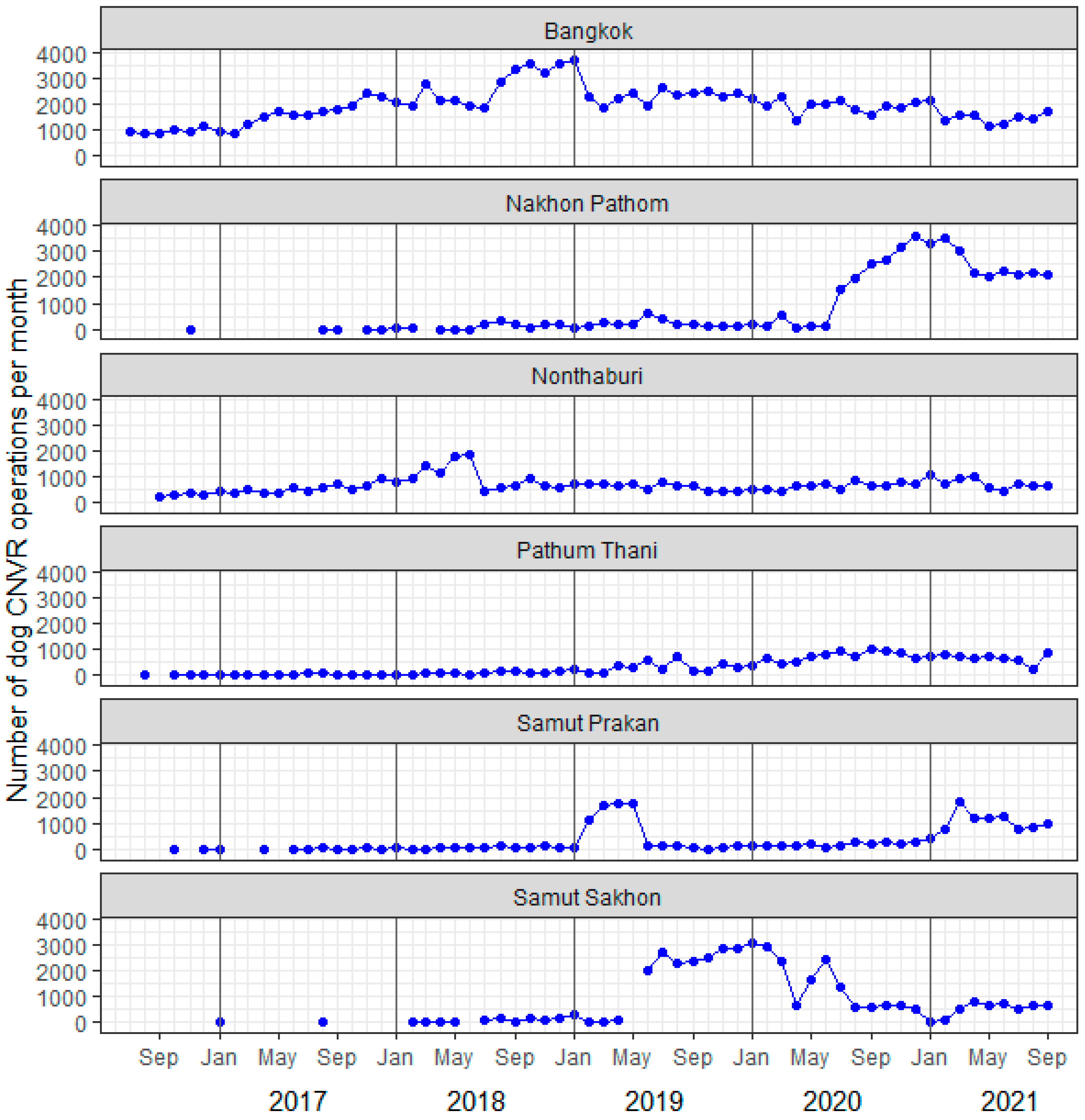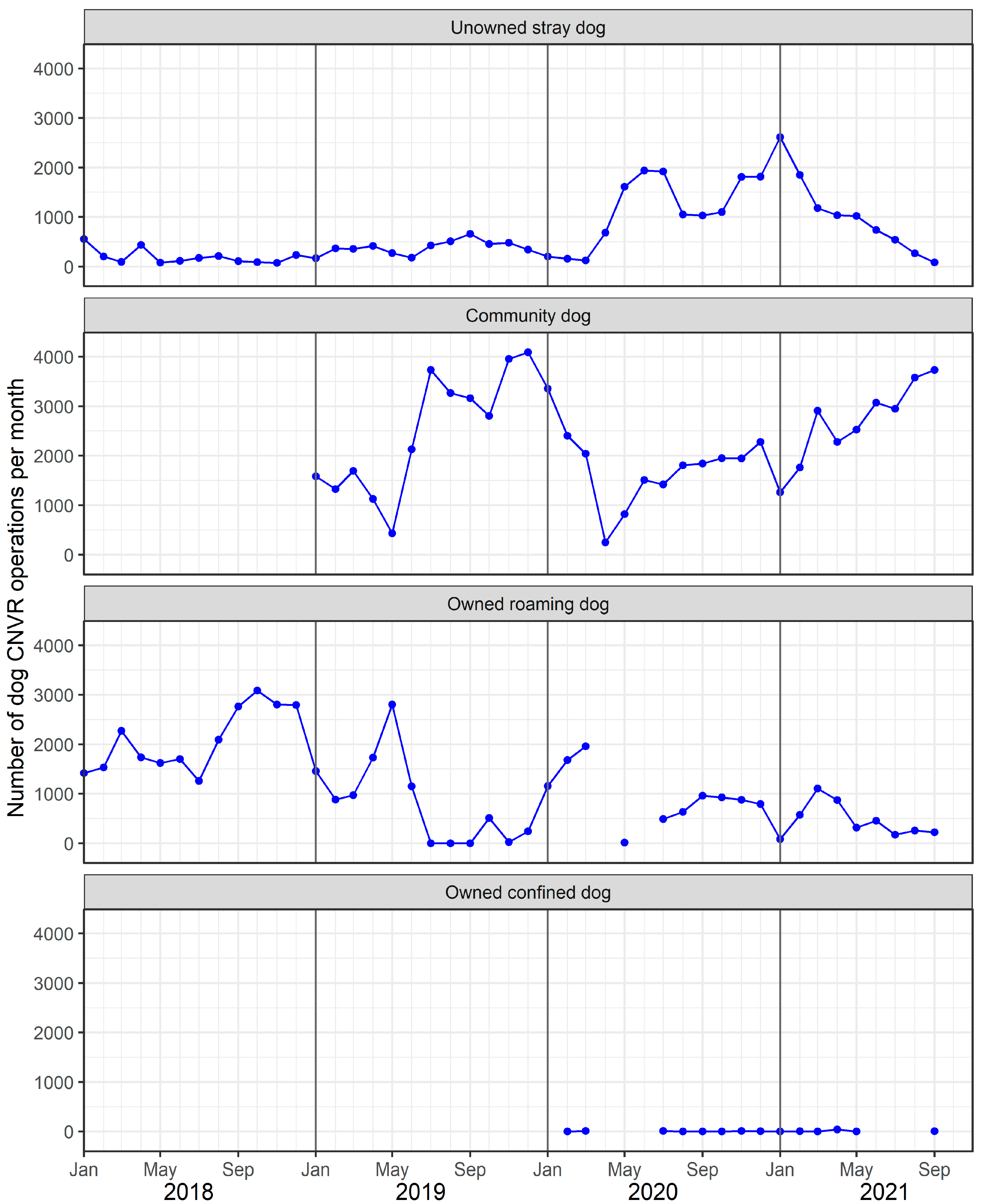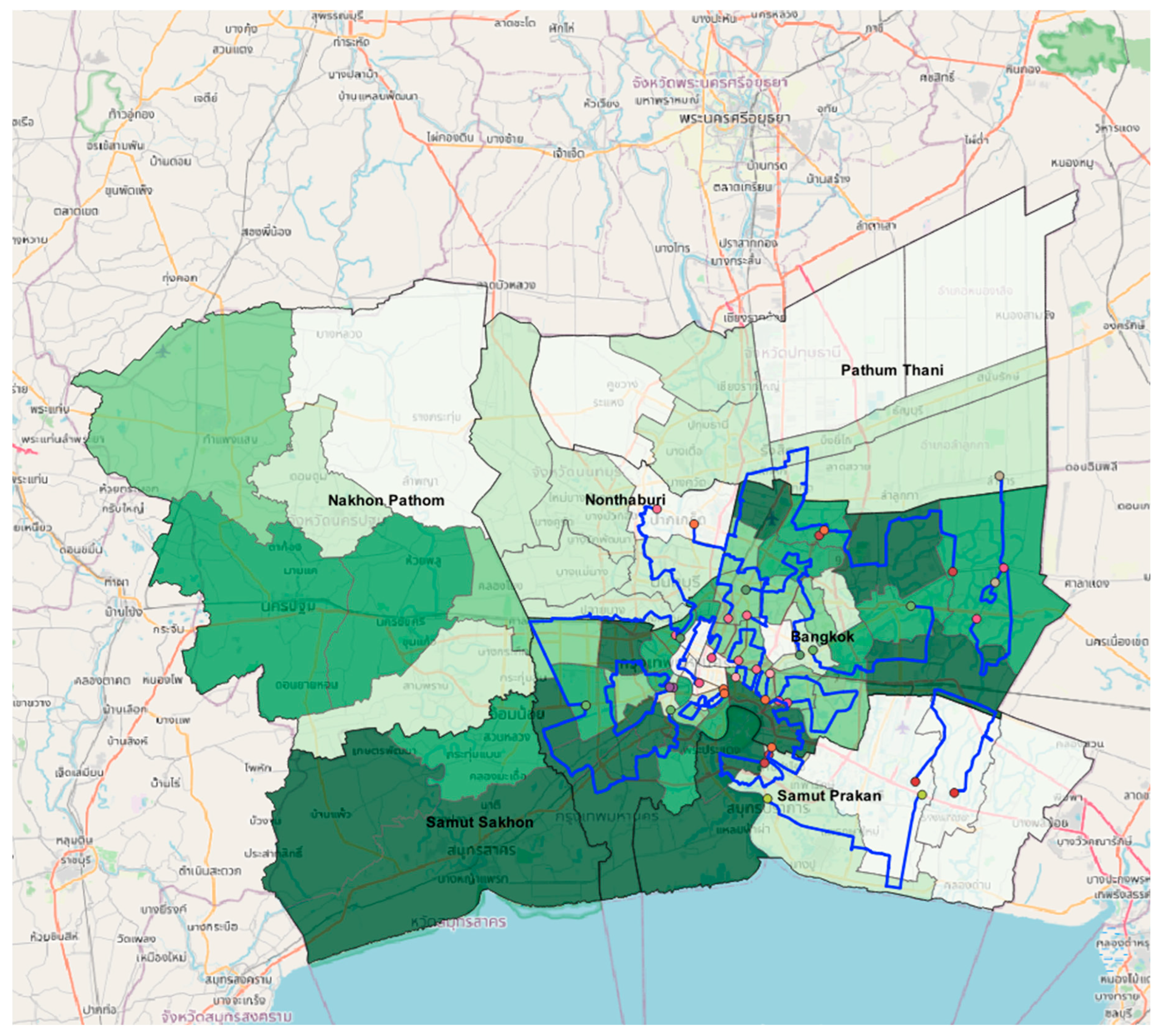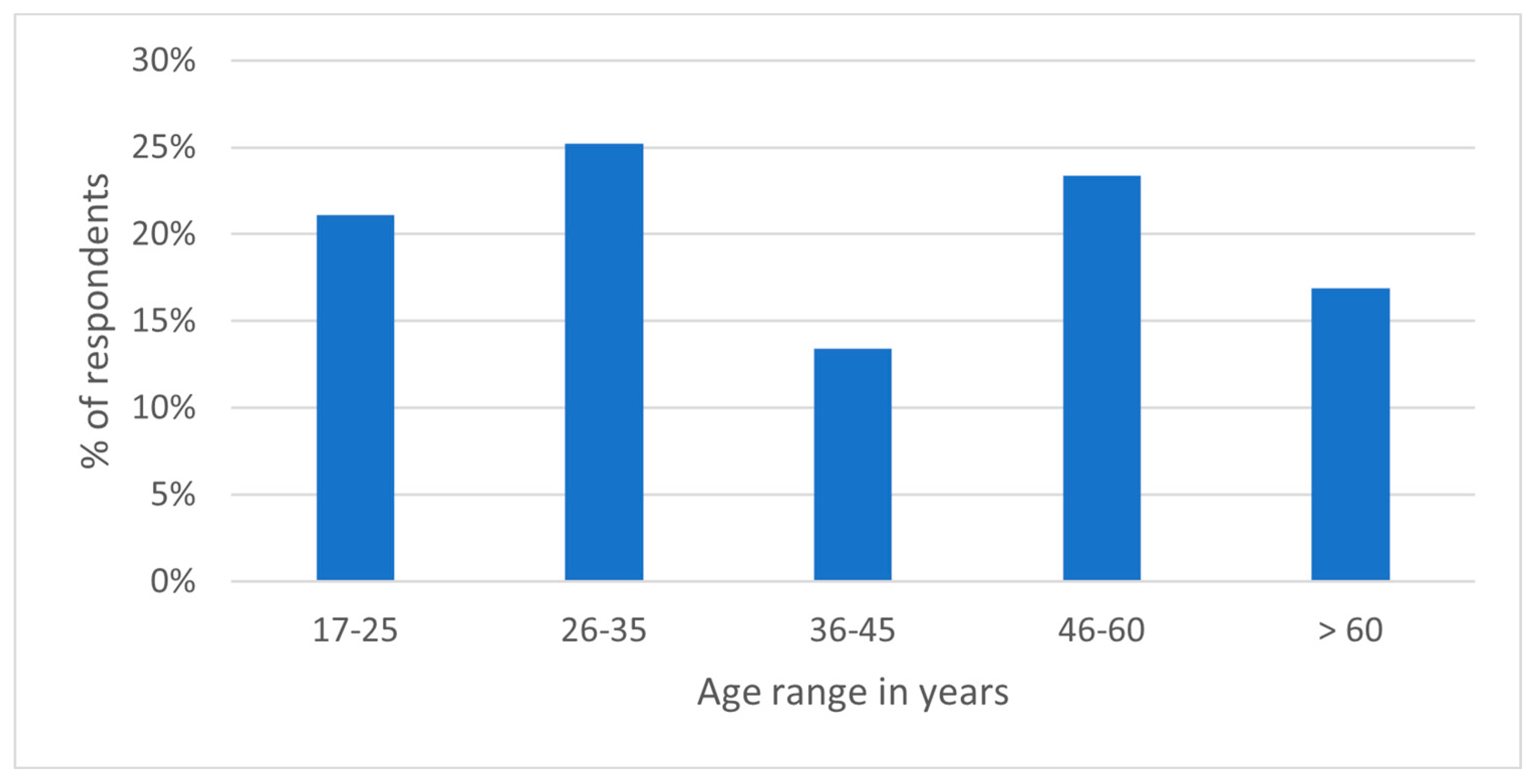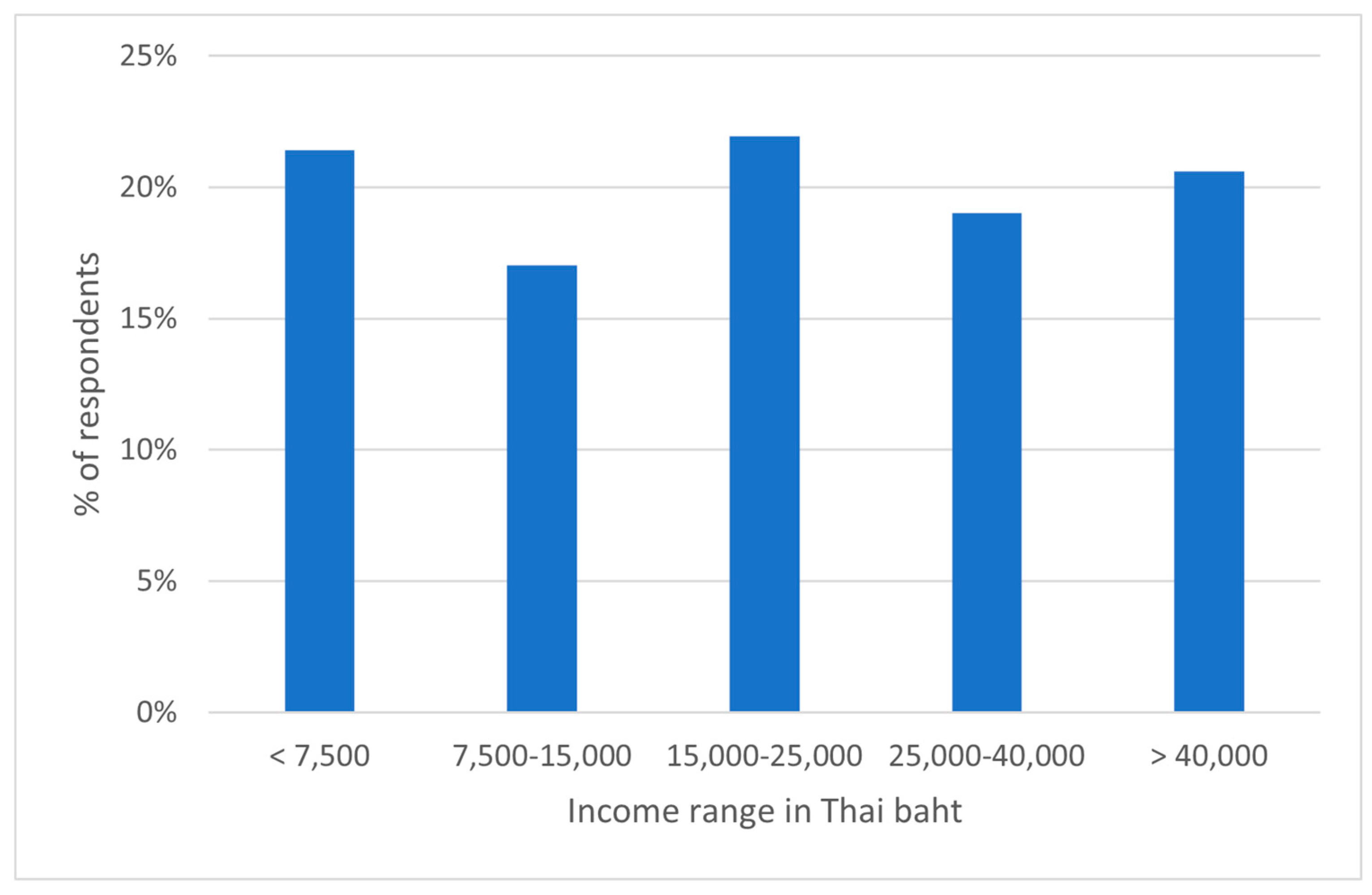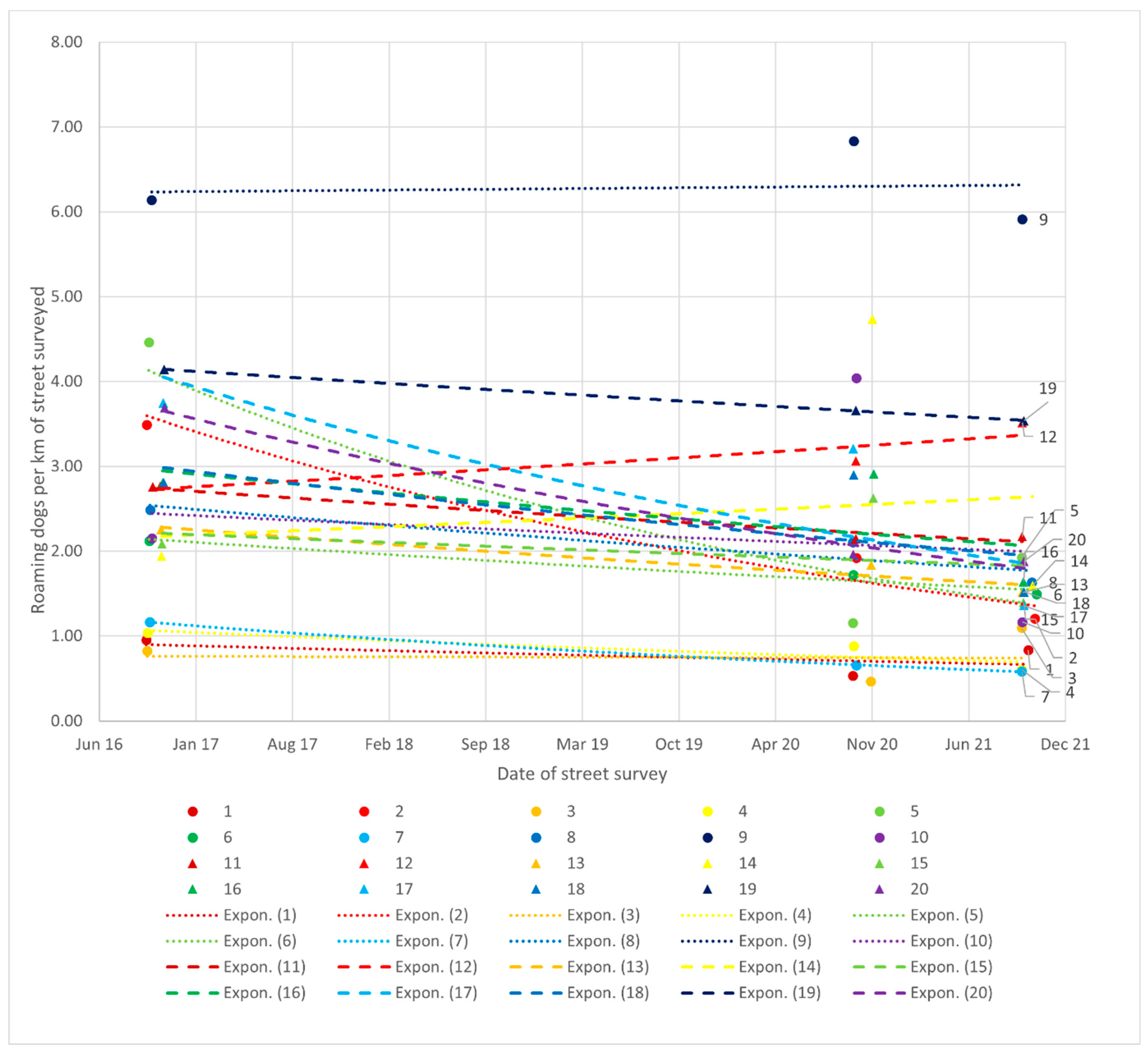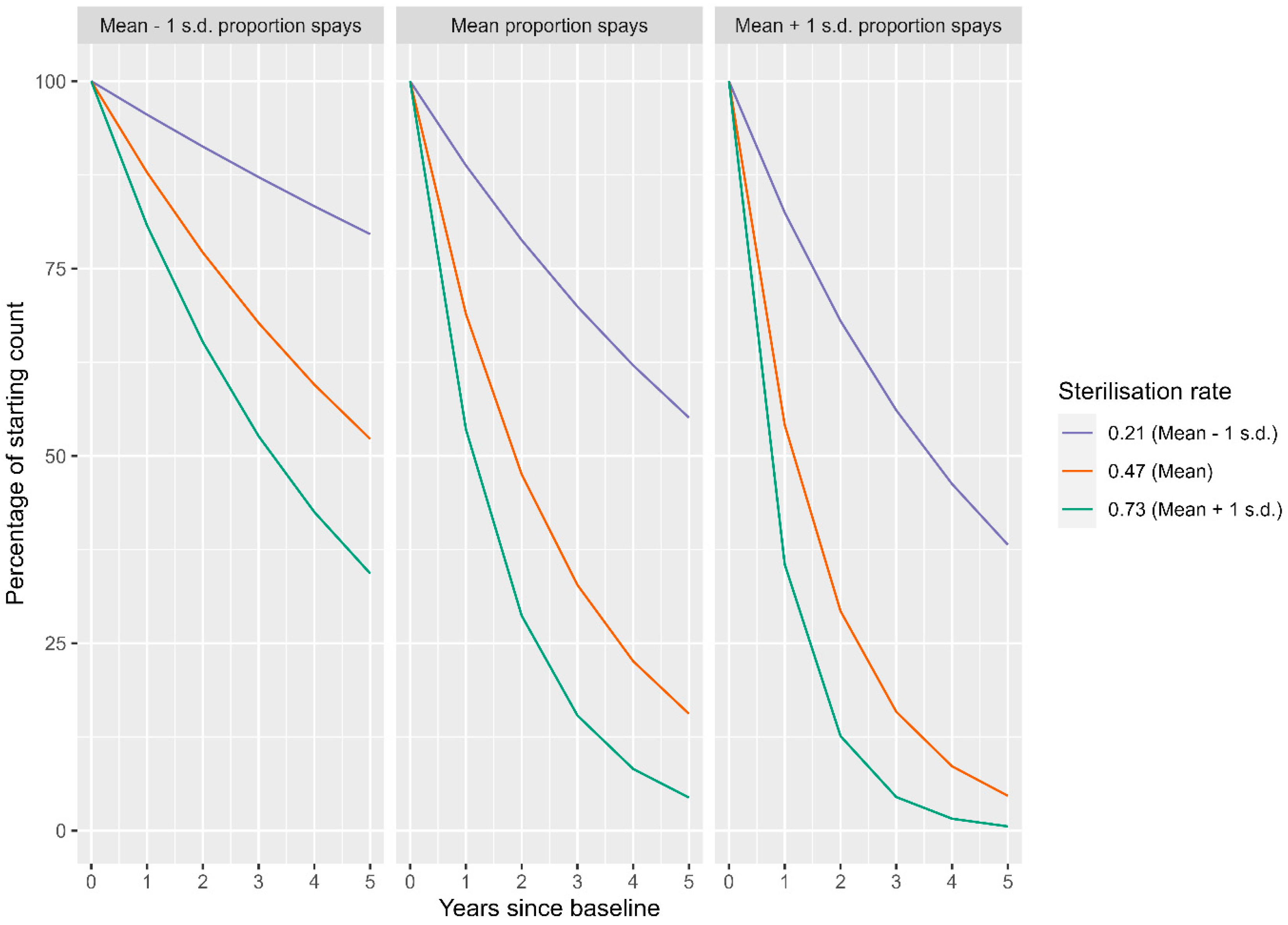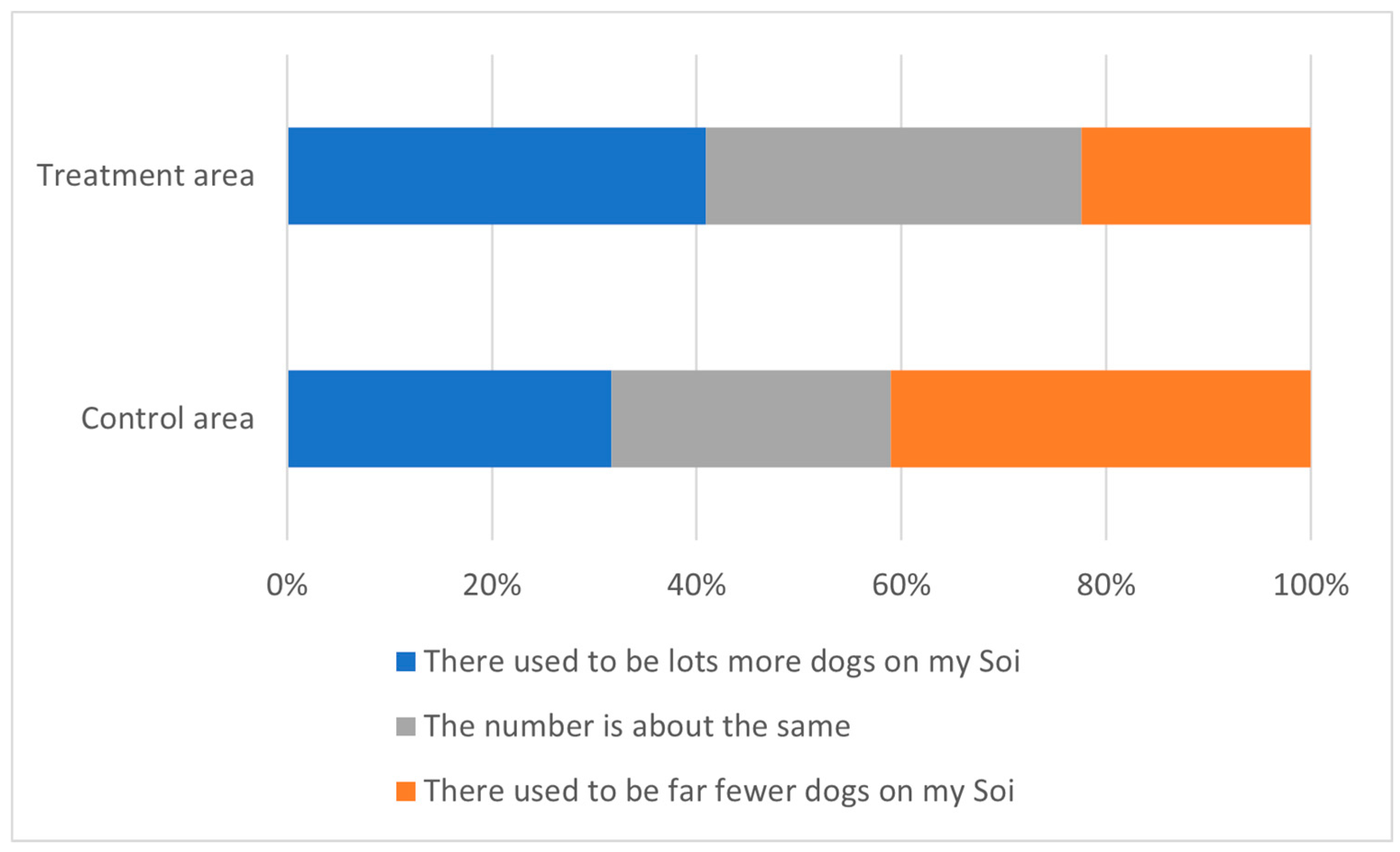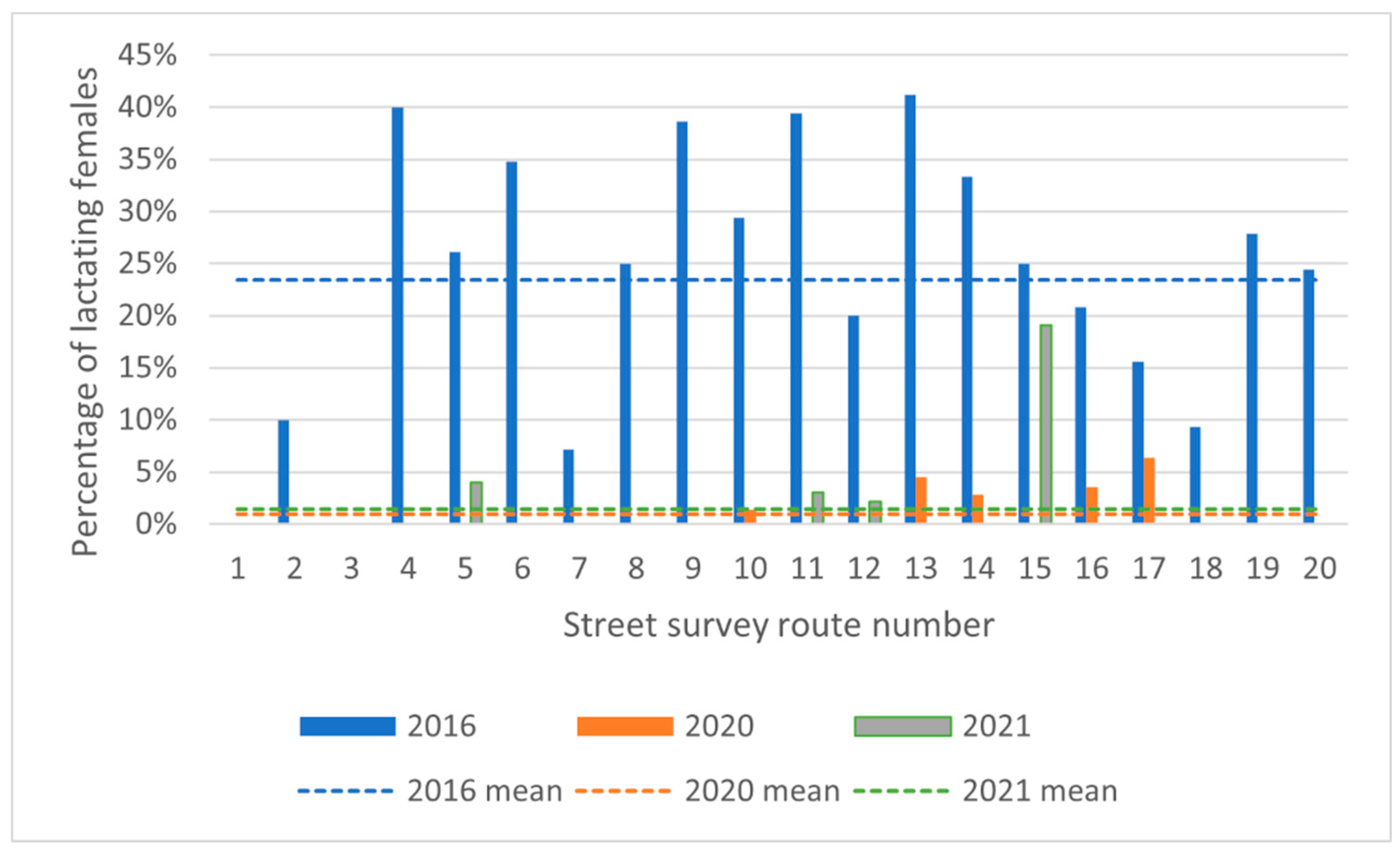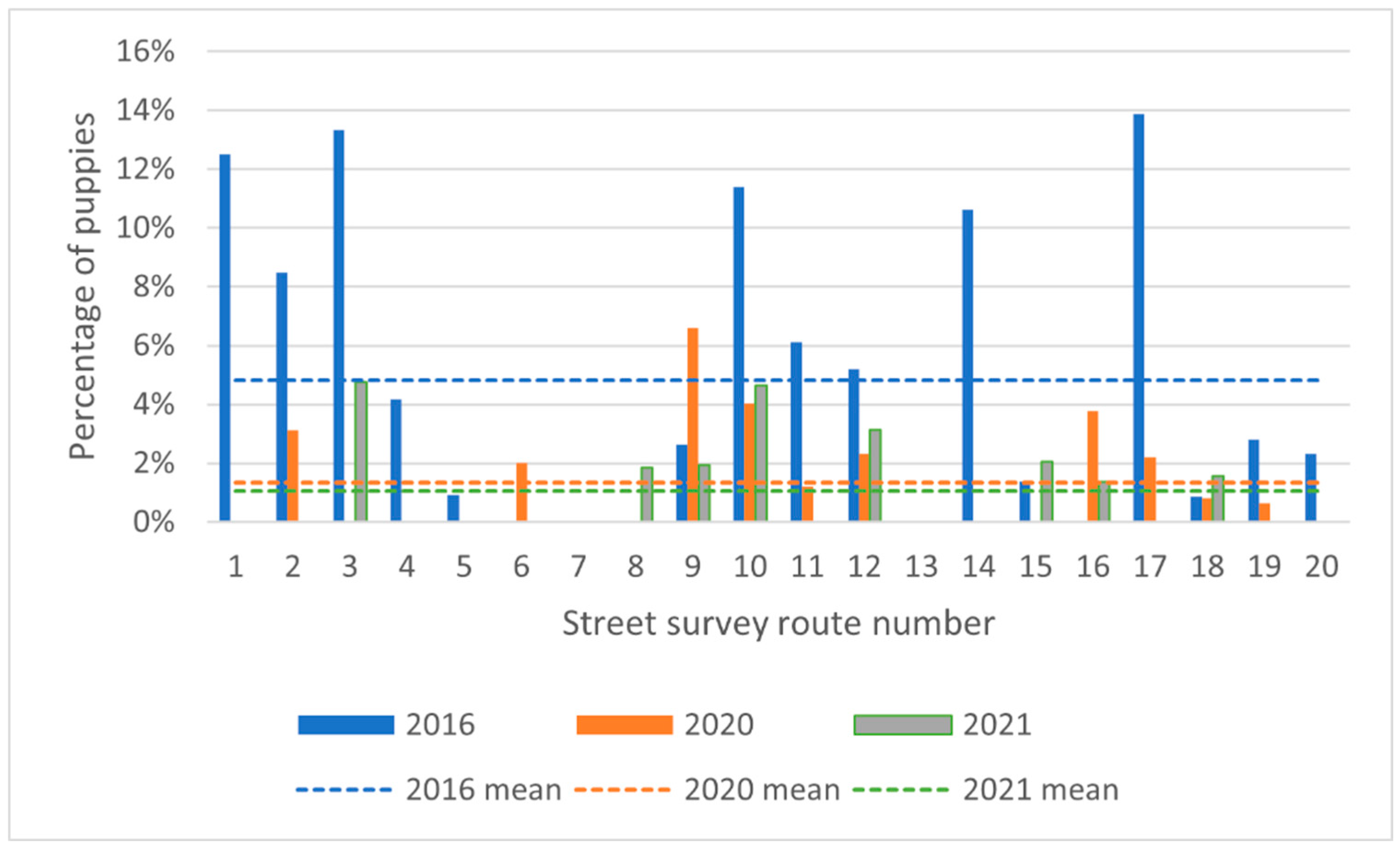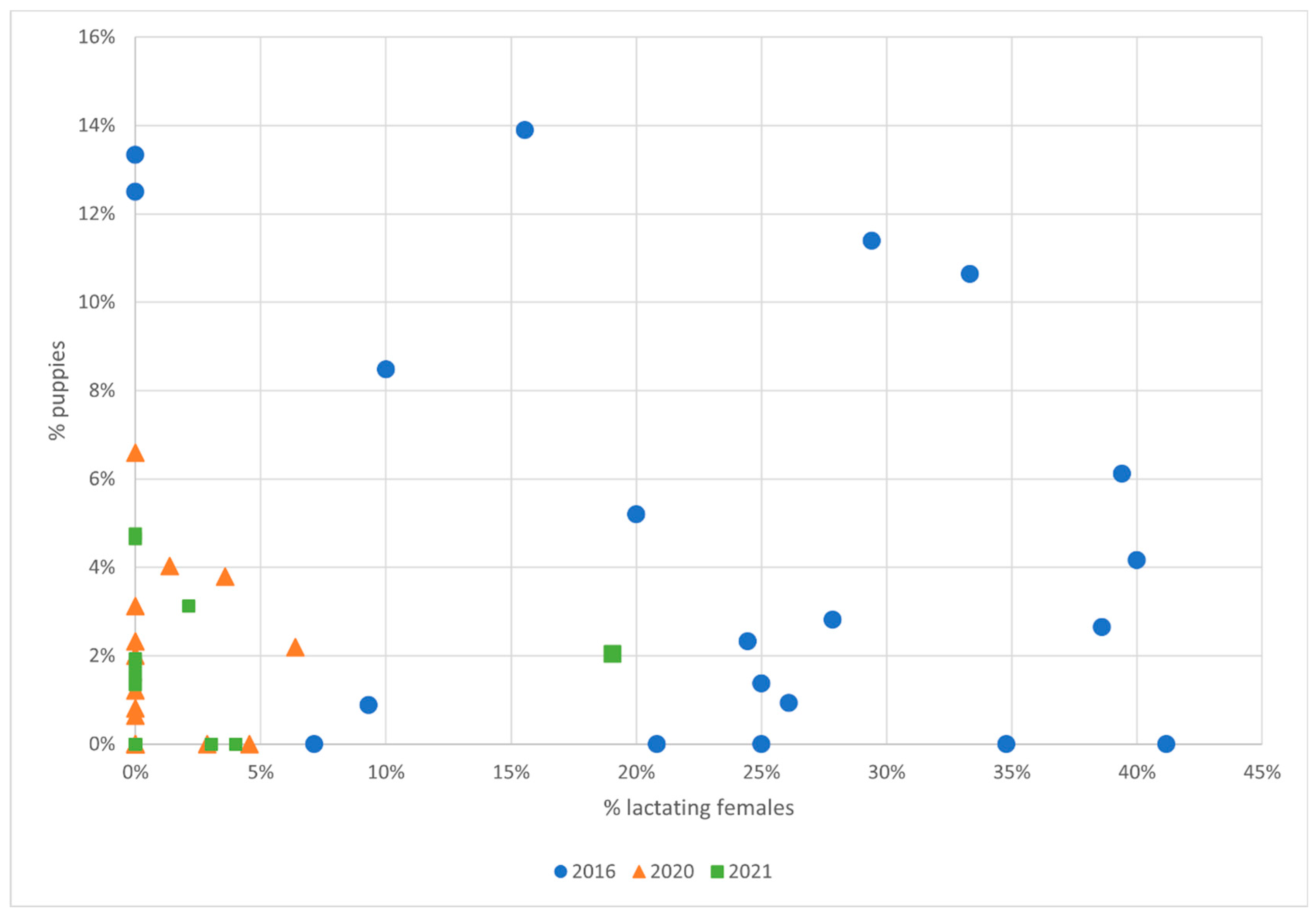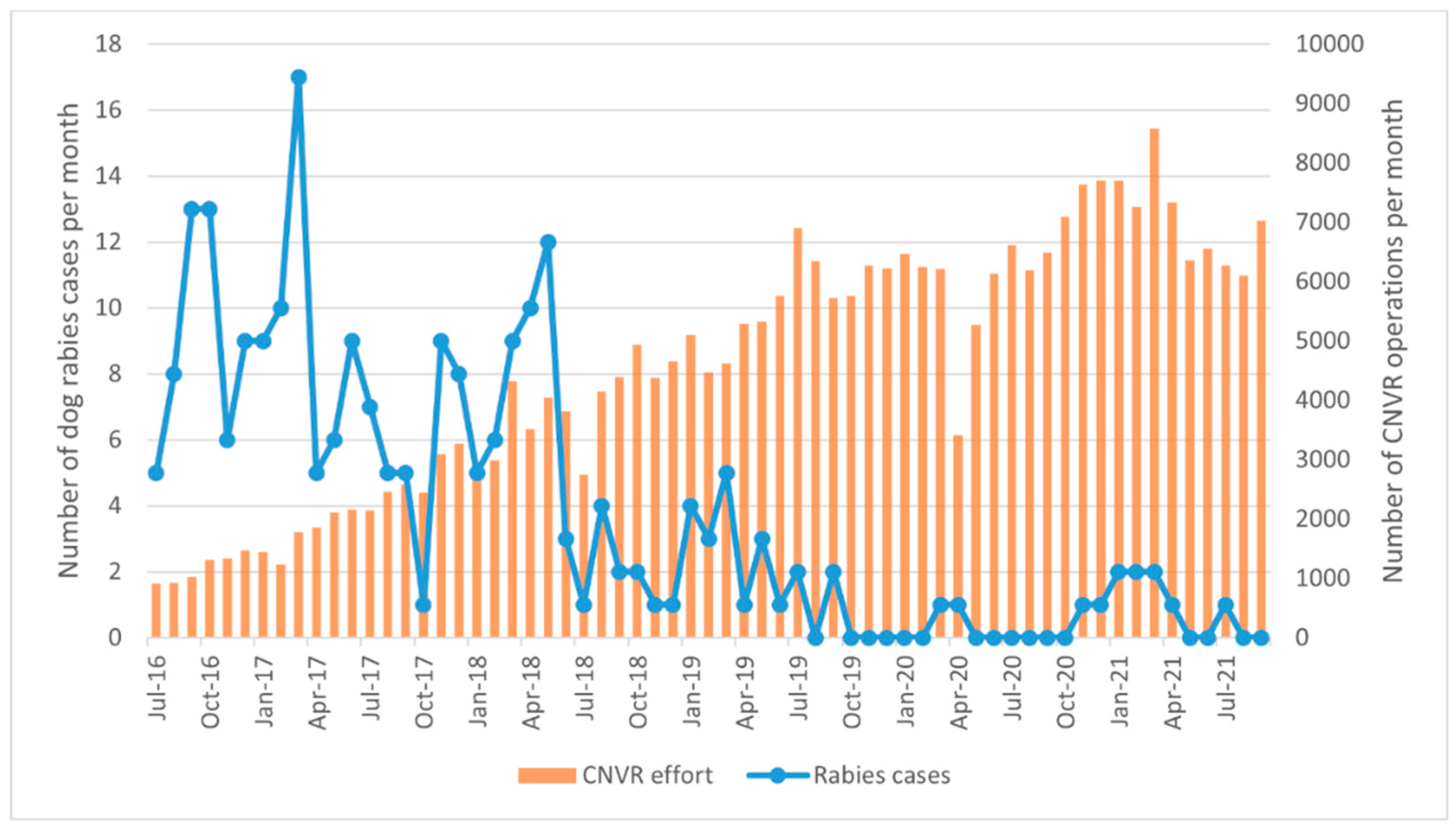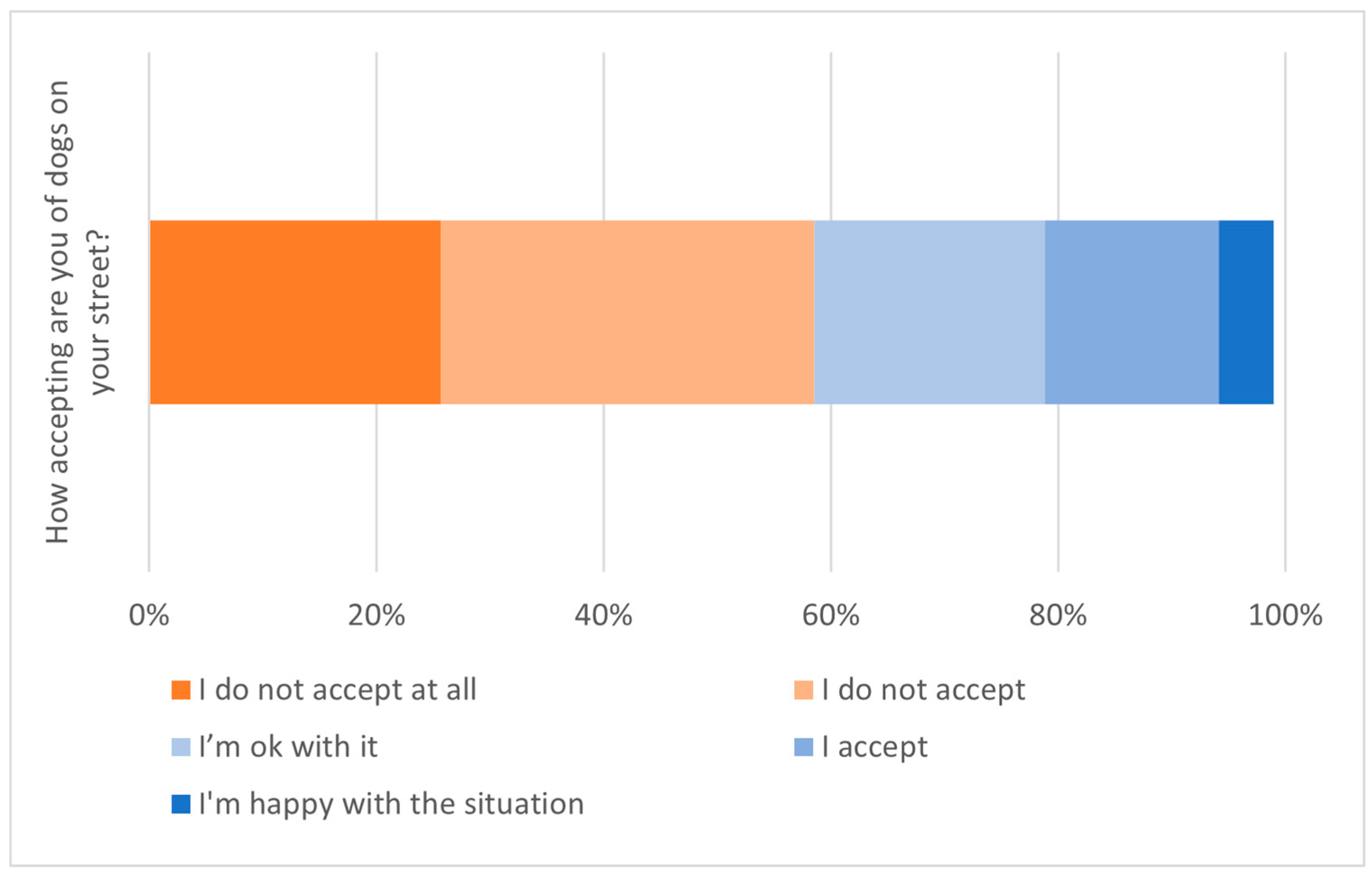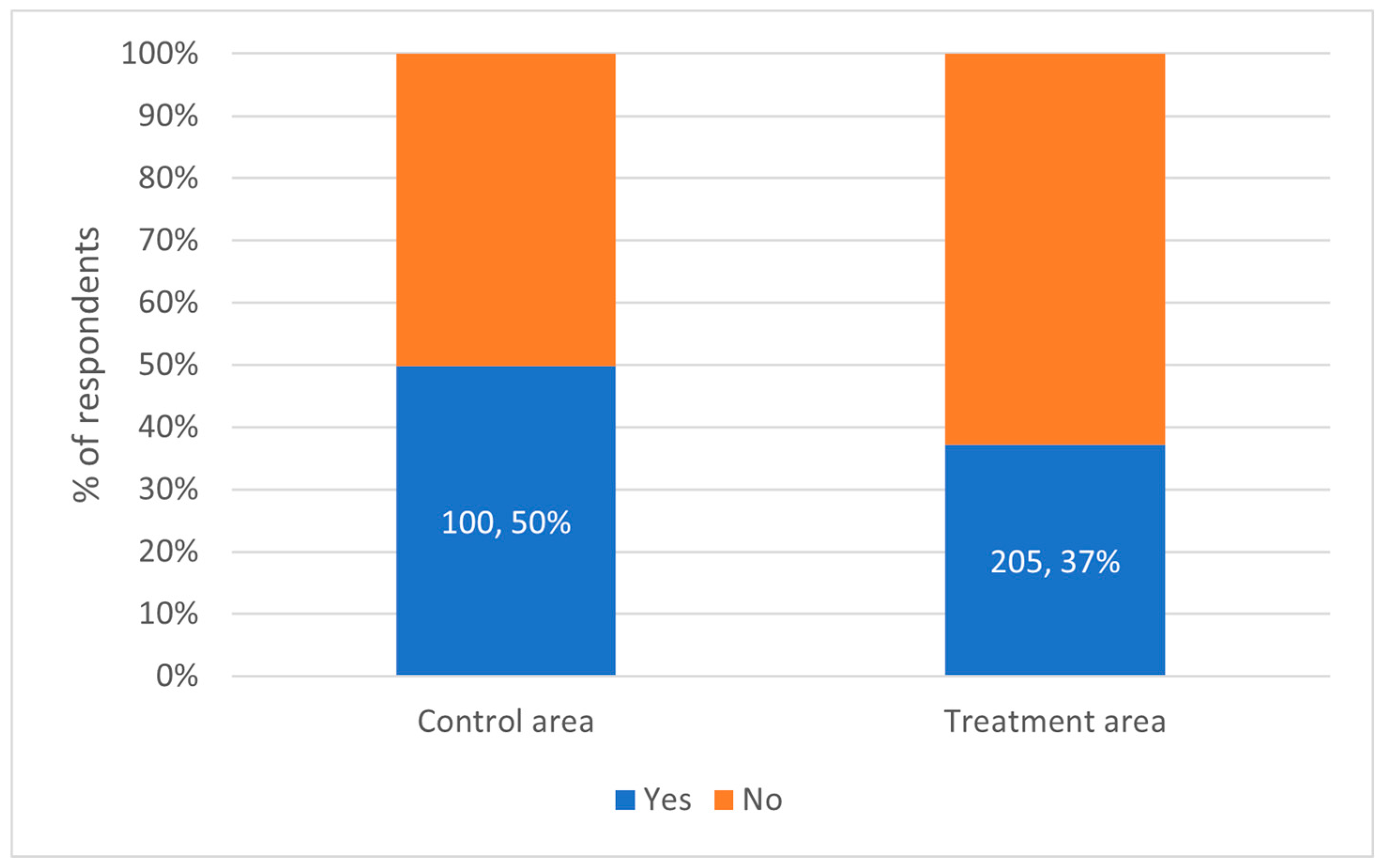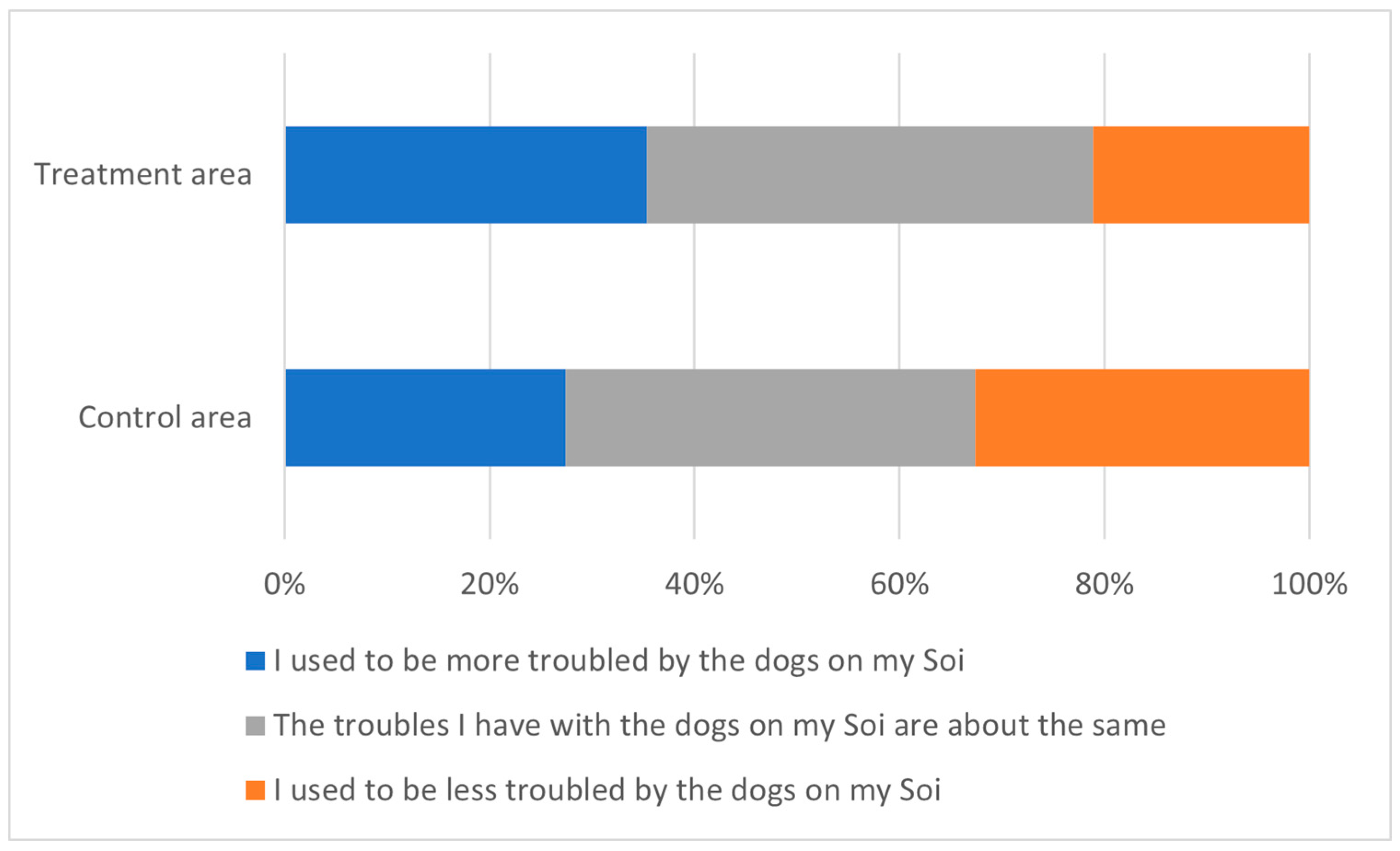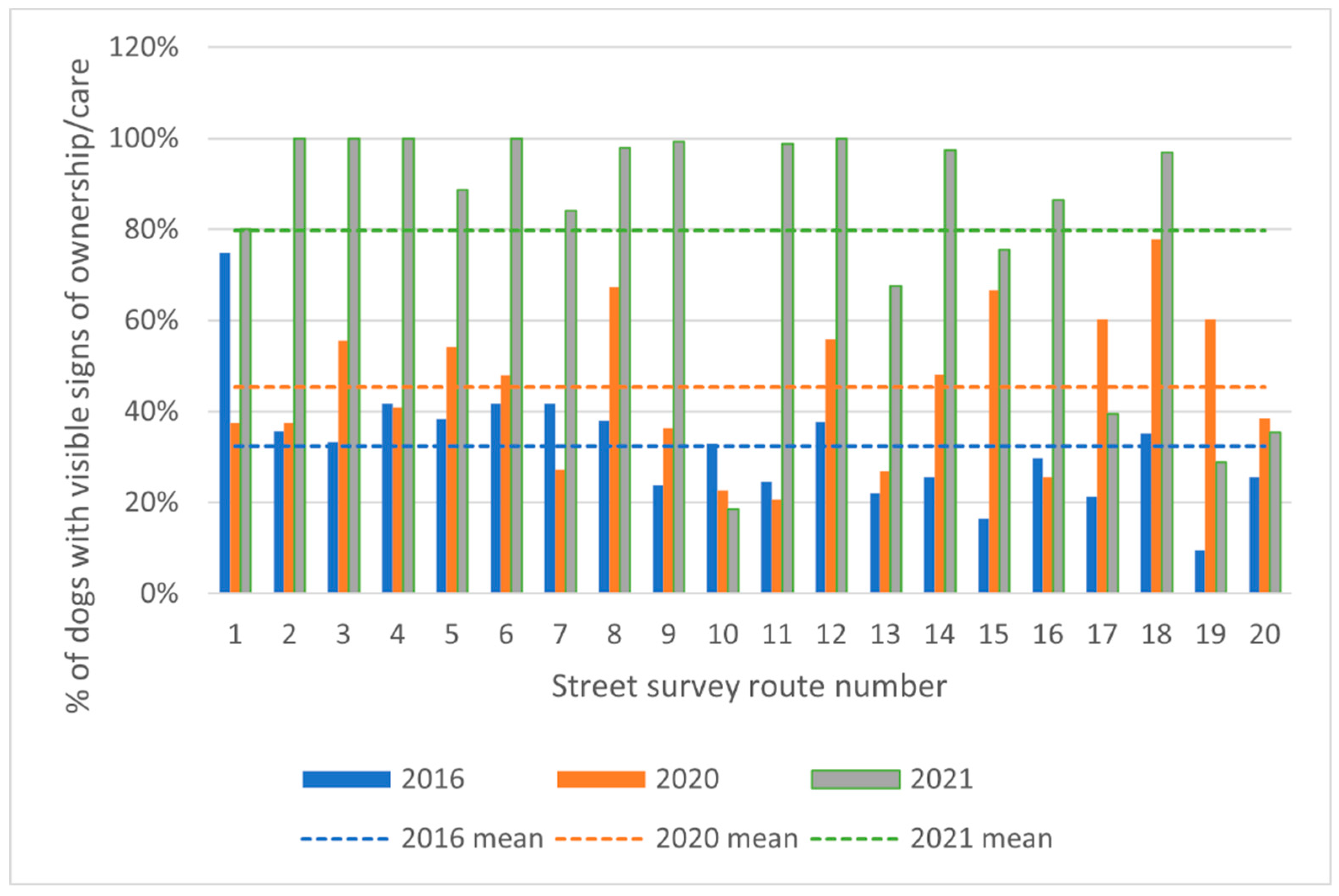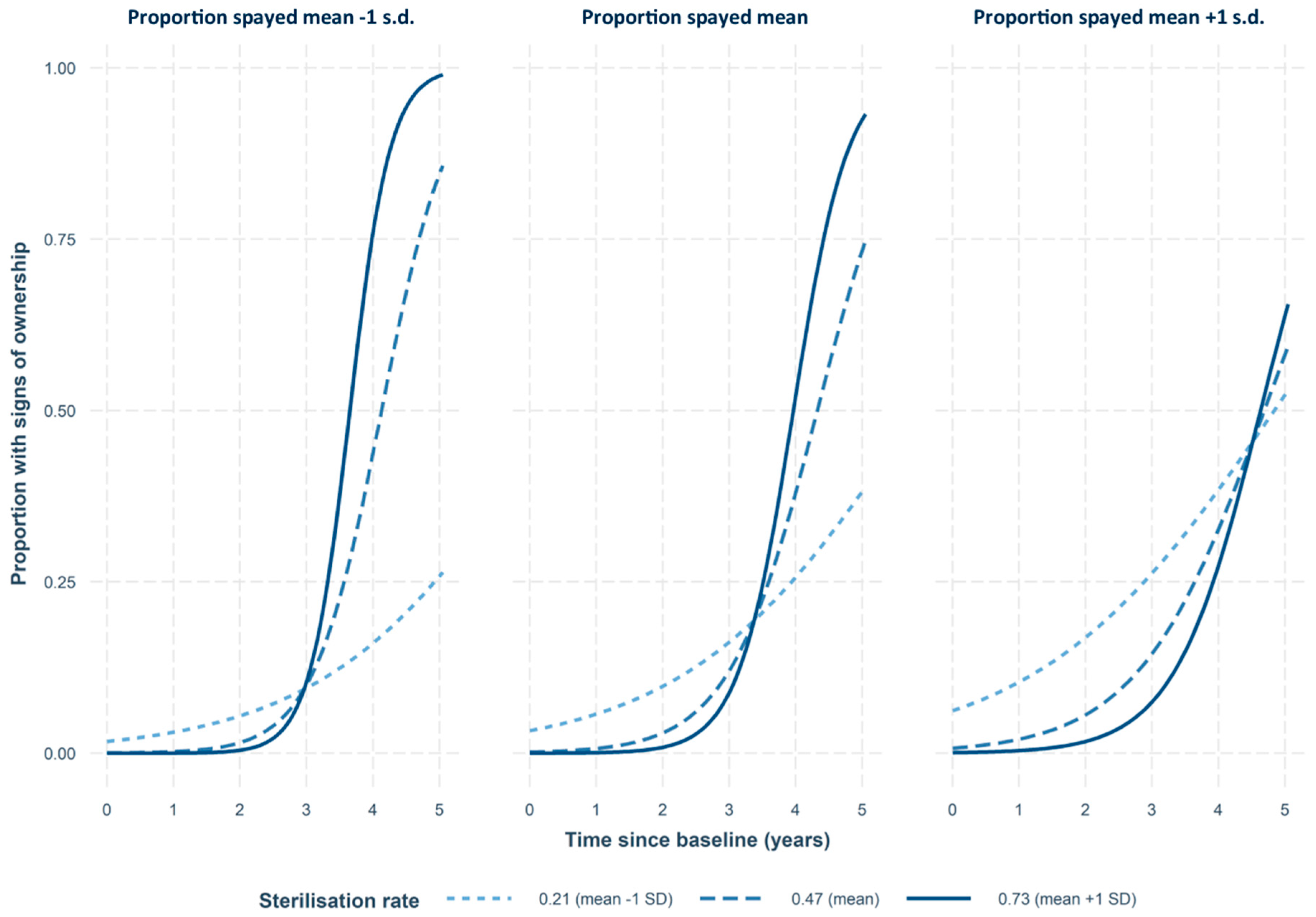1. Introduction
Domestic dogs have evolved alongside humans for thousands of years, to become ubiquitous around the world as both companions and working animals. Current global population estimates stand at between 700 million (Hughes & Macdonald, 2013) and 987 million (Gompper, 2014) dogs, most of which are free-roaming for at least part of the day.
Although many dogs are valued by their owners and caretakers, they can have negative consequences for animals, people and the environment, especially when free-roaming. These negative consequences include disease transmission, dog bites, road traffic accidents, nuisance behaviours, fouling of public places, predation of wildlife and livestock. These dogs can also experience poor animal welfare. In recognition of these risks, dog population management (DPM) is used to influence dog population dynamics to produce safer populations of dogs, where each dog is wanted, cared for and managed in a way that reduces risks. Dog population management is the subject of international standards (World Organisation for Animal Health, 2022) and guidelines (ICAM, 2019).
The interventions required as part of DPM will differ according to the local dog population dynamics, how people interact with dogs and the goals of DPM important to the local community (ICAM, 2019). Where unowned dogs are tolerated and fed by local people, often termed ‘community dogs’, the intervention of Catch, Neuter, Vaccinate and Return (CNVR) is appropriate, as this both limits reproduction and builds herd immunity to minimize rabies transmission between dogs and to people (World Organisation for Animal Health, 2022). This approach has been used successfully with community dogs in South East Asia to control rabies (Häsler et al., 2014; Larkins et al., 2020; Reece & Chawla, 2006), reduce the density of free-roaming dog populations (Reece & Chawla, 2006; Totton et al., 2010), reduce dog bites (Reece et al., 2013) and improve dog welfare (Totton et al., 2011; Yoak et al., 2014).
Greater Bangkok is comprised of the city of Bangkok and five adjacent provinces, covering nearly 8,000 km2 and home to over 15 million people. According to a 2010 Bangkok Metropolitan Authority survey there are 102,490 free-roaming dogs in Greater Bangkok (results reported on webpage of Office of Veterinary Health). These dogs appear to be well tolerated and are commonly fed by sympathetic Bangkok citizens, although there are complaints about free-roaming dogs reported to local authorities and a concern about the risk of rabies transmission from dogs. To achieve the beneficial outcomes of CNVR described previously, a sufficient proportion of the dog population would need to be reached, which can be a challenge across a large metropolitan area (Tenzin et al., 2015). CNVR efforts could be distributed evenly across the metropolitan area or targeted to areas with frequent complaints from residents. However, this is likely to result in a low CNVR coverage across the entire area which may both be less effective in terms of herd immunity for rabies control (Townsend et al., 2013; Wallace et al., 2017) and population decline (Boone et al., 2019). Conversely, computer simulation models of animal populations have suggested that high intensity CNVR is more effective for reducing population size (Shamsaddini et al., 2022; Smith et al., 2022). Even when the same total number of CNVR operations are used across the project time period, ‘front loading’ these to intensify the effort at the outset leads to greater declines in population size because birth of females that would themselves subsequently give birth is prevented by the first intense effort (Benka et al., 2021). Soi Dog Foundation, in partnership with Dogs Trust Worldwide, proposed to deliver CNVR using a high intensity rotational approach, focusing on each district (local authority area) until at least 80% of the free-roaming dog population had been reached, before moving to the neighbouring district. Then, once all districts had been reached, returning to the first district to restart the next ‘round’ of CNVR.
Evaluation of DPM interventions are essential for adaptive management of interventions and to inform DPM development in other locations, but are rarely conducted or published (Hiby et al., 2017) with some notable exceptions (Barnard et al., 2015; Belo et al., 2017; Ma et al., 2020; Reece & Chawla, 2006; Totton et al., 2010; Utami et al., 2019; Yoak et al., 2014). An evaluation of this CNVR approach in Greater Bangkok utilized multiple methods to establish change in a number of indicators: Free-roaming dog density and breeding activity, dog rabies cases, and citizens perceptions and care of free-roaming dogs.
2. Materials and Methods
2.1. CNVR
The CNVR intervention was conducted by mobile teams of dog catchers/handlers and veterinary staff working in field clinics. Field clinics are temporary clinics equipped for conducting surgical sterilization (including autoclaves, gaseous anaesthesia, preparation and recovery/holding areas), set-up in locations identified as suitable by local community or government leaders, such as community centres or temples. Dog catchers/handlers survey the district or sub-district in advance to establish the number and locations of free-roaming dogs and to inform and engage the support of dog owners and caretakers/ “feeders” in accessing dogs for CNVR (the ‘pre-clinic survey’). Ownership of free-roaming dogs is established by asking households and business in the immediate area about each individual dog. An owned dog is a dog for whom an individual, household or business claims ownership and a right to consent, or not, to a CNVR operation. A community dog is a dog for whom one or more individuals, household or business express an interest in the welfare of a dog and report to provide regular care but do not claim ownership, they may be recruited to help with accessing the dog for CNVR but this is not a requisite for the definition of a community dog. An unowned dog is a dog for whom no one claims ownership nor interest in providing regular care.
On CNVR operation days, the dog catcher/handlers start in the early morning to catch free-roaming unowned dogs and collect owned and community dogs from owners and community caretakers, including obtaining written consent for surgical sterilization form owners. These dogs are transported in well ventilated vans to the field clinics for pre-operative examination, surgery and recovery. Once dogs are recovered, usually within the same day, but may be longer depending on the condition of the dog, the dogs are returned as close as possible to the point of capture or directly to their owner. Dogs are marked with an ear tattoo whilst under anaesthesia at the field clinic.
Dog catcher/handlers report when the only unsterilized dogs remaining in the area are those that have proved too difficult to catch. They then conduct a visual survey along a convenient and approximately representative route within the area to observe a random sample of the free-roaming dogs to confirm the percentage of dogs that have been caught (the ‘post-clinic survey’). If this percentage is above 80%, the CNVR team moves to the next district.
The CNVR operation started with just one mobile team in July 2016 and expanded to 6 mobile teams and 2 additional static clinic teams (plus mobile dog catching/handling staff). These teams were staffed by Soi Dog Foundation and a veterinary clinic project partner called ‘Forget Me Not’.
2.2. Clinic Records
Data for every dog reached by the CVNR intervention was recorded in MS Excel, including their type (unowned stray, community dog with at least one identified caretaker(s), owned but unconfined for part of the day, or owned and confined to the home), location caught/collected, age (puppy below 6 months or adult), sex, reproductive status (pregnant), weight, medicines received, operation completed, operating veterinarian, any complications, and ear tattoo number.
2.3. Street Survey
An observational survey of free-roaming dogs was completed in October-November 2016 along 20 routes that covered public roads in Bangkok, Nonthaburi, Samut Prakan and Pathum Thani (the Provinces of Nakhon Pathom and Samut Sakhon were not included in this survey but are within the scope of the Greater Bangkok CNVR project). This survey recorded the number of free-roaming dogs seen, their basic demography and their visible welfare state. This survey was replicated in 2020 and 2021, keeping as close as possible to the original survey protocol, to estimate changes in the free-roaming dog population. Data was recorded on paper in 2016 and on the Talea app and web survey tool in 2020 and 2021 (
https://www.icam-coalition.org/tool/talea-street-survey-app/). The full survey protocol is available in
Supplementary Materials. Data was downloaded from the Talea website to Microsoft Excel and analysed using R version 4.2.1, (R Core Team, 2022) via RStudio (RStudio Team, 2020).
2.4. Variable Calculation from Street Survey and Clinic Records
Clinic records were used to calculate two variables for analysis of their impact on dog density: the sterilization rate and the proportion of spays.
2.4.1. Calculating the Variable ‘Sterilization Rate’ for Each Survey Route at the Time of Each Survey Event
It was assumed that the sterilization effort at the time of the 2016 survey was 0. For each district, the total number of sterilizations up to the time of the survey event was divided by the total street length within that district. This led to an estimated number of sterilizations per km of street for that district; an estimate of CNVR effort that took into account the size of the district as represented by street length (free-roaming dogs tend to be associated with streets, rather than the space between streets which is usually filled with buildings, hence street length rather than area is used as a measure of habitat capacity).
Nearly all 20 survey routes passed through more than one district, so an estimate of CNVR effort by route required further calculation. For each route, the number of kms contributed by each district was calculated. The number of kms contributed by each district towards a route was multiplied by the sterilizations per km for that district, the resulting number of sterilizations were summed for all districts traversed by that route, then divided by the total route length in km. Creating a single ‘weighted mean sterilization’ for each route at that time; this is the average number of sterilizations performed per km of route, taking into account the street length or ‘weight’ provided by each district.
The next step was to standardize the weighted mean sterilization by time to get the average sterilization effort per year for each route; this is the average number of sterilizations performed per km of route, per year. The weighted mean sterilization value calculated from the 2016-2020 sterilization data was divided by 4 to get the average sterilizations per year at the time of the 2020 survey; and the weighted mean sterilization value calculated from the 2016-2021 sterilization data was divided by 5 to get a measure of sterilization effort at the time of the 2021 survey.
A final stage of standardization was to divide the weighted mean sterilization per year for each route by the starting density of dogs on that route in 2016. This was because some routes had a very low density of dogs in 2016, so the weighted mean sterilization per year was low as there just weren’t the dogs available to sterilize - however this lower number of sterilizations was still providing a good sterilization coverage of the available dogs. This final sterilization rate is therefore the average number of sterilizations performed per km of route, per year as a proportion of the available dogs according to the density recorded on the 2016 survey. Hence a value of 1 implies 100% of the available dogs are being sterilized per year.
2.4.2. Calculating the Variable ‘Proportion Females’ for Each Survey Route at the Time of Each Survey Event: A Measure of Prioritization of Females Spays within the CNVR Effort
For each district, the number of females spayed was divided by the total sterilizations recorded up to the time of the survey. This is a measure of the proportion of sterilizations that were female spays for each district in the period preceding the survey.
Nearly all survey routes passed through more than one district, so an estimate of proportion female spays by route required further calculation. For each route, the number of kms contributed by each district was calculated. The number of kms contributed by each district towards a route was multiplied by the mean sterilizations per km for that district, the resulting number of sterilizations were then multiplied by the proportion of female spays for that district, giving an estimate of the number of females spayed for the section of route contributed by the district. The estimate of female spays for all contributing districts were summed for the route, this was then divided by the total number of sterilizations from the contributing sections of the districts; the resulting figure was the mean proportion of females in the sterilization effort for the route, taking into account the street length or ‘weight’ provided by each district.
Although the rate of sterilization and time spent on CNVR could be assumed to be 0 at baseline, it doesn’t make sense to assume a 0 proportion of females at baseline. Hence the variable proportion of females was calculated using the full 5 years of sterilization data and used in analysis as a route (higher) level variable rather than a survey (lower) level variable. It was also ‘centred’ by using a z transformation ((x-mean)/s.d.) so that the mean proportion female (0.62) became 0 and the values were distributed either side of 0.
2.5. Attitude Survey
An attitude survey was conducted in 2020 to measure public perceptions of free-roaming dogs in Greater Bangkok. This survey included respondents living in areas that had received intensive CNVR effort and those living in areas of Greater Bangkok that were yet to receive CNVR attention from the CNVR project.
The attitude survey was delivered online, because COVID-19 restrictions prevented door-to-door recruitment of respondents in 2020. The attitude survey was comprised of a consent statement and 13 questions. These questions were translated into Thai and hosted online using Alchemer (formerly Survey Gizmo), a web-based survey platform.
It was important that recruitment of respondents was achieved without the respondent knowing that the survey was created by Soi Dog Foundation; to avoid any potential biasing of responses. Respondents were recruited through two Soi Dog independent routes: 1) A partnership with the veterinary department of Kasetsart University was established to support recruitment of respondents using a Facebook page that explained the nature of the survey and hosted the link to the survey itself. This Facebook page only displayed the name and logo of Kasetsart University. 2) Contacts within local government offices were asked to distribute the link to the online survey through their residents networks, without mentioning Soi Dog Foundation. The questionnaire is available in
Supplementary Materials.
Data was downloaded from the Alchemer website to Excel and analysed using R version 4.2.1, (R Core Team, 2022) via RStudio (RStudio Team, 2020).
2.6. Dog Rabies Cases
The number of laboratory confirmed animal rabies cases in the Greater Bangkok area from June 2015 to Oct 2021 was shared with Soi Dog Foundation for analysis of the CNVR effort. This data was stripped of any personal information about each case, leaving only the animal species, ownership status, sub-district in which the suspect animal was located and the date the sample was submitted for laboratory analysis.
2.6. Ethical Approval
All procedures performed in studies involving human participants were in accordance with the 1964 Helsinki declaration and its later amendments or comparable ethical standards. In addition, all methods were approved by the Dogs Trust Ethical Review Board of Dogs Trust UK (reference number ERB037 on 21 October 2020).
3. Results
3.1. CNVR Effort
From 1 July 2016 to 30th September 2021 the CNVR project achieved a total of 286,969 sterilizations. These sterilizations were split unequally between the provinces (
Table 1 and
Figure 1), as the CNVR project started in Bangkok city, then expanded to the other 5 provinces.
The type of dog reached by the CNVR project was recorded for 195,311 (68%) of the dogs, dog type was not recorded for all dogs early in the CNVR project. The type of dog reached by the CNVR project varied over time (
Table 2 and
Figure 2).
The sterilization rate for each survey route in 2016 was set at 0; in 2020 the mean was 0.48, with a range from a minimum of 0.04 to a maximum of 0.97; in 2021 the mean was 0.47, with a range of 0.15 to 0.90. The proportion of spays was calculated for each route using the full 5-years of data, resulting in a mean of 0.62, minimum of 0.55 and maximum of 0.77.
3.2. Street Survey
The street surveys included 20 routes (
Figure 3) totalling approximately 600km of street and observation of between 1141 and 1626 free-roaming dogs each year (
Table 3). Each route was completed within 2-3 hours, a total of 40-60 hours of work for a survey team. In 2016, a single surveyor completed all 20 routes over 20 days; in 2020, 4 pairs of surveyors completed 5 routes per pair over 14 days; and in 2021, one lead surveyor completed all 20 routes over 20 days, always accompanied by one of 4 assistant surveyors, creating a survey pair of recorder and navigator/driver.
3.3. Attitude Survey
The attitude survey collected 757 responses from Greater Bangkok between September 30th and Nov 14th 2020; 202 from ‘control’ districts where no intensive CNVR effort had yet occurred and 555 from ‘treatment’ districts that had already benefited from CNVR.
There was a relatively even spread of respondents across age (
Figure 4) and income (
Figure 5). This was reassuring as the online method of recruiting respondents could have created a bias towards younger and more affluent respondents.
3.4. Change in Free-Roaming Dog Density
3.4.1. Change in Free-Roaming Dog Density over Time
The recorded dog density in 2016 was an average of 2.66 (SE 0.29) dogs per km, this fell to 2.47 (SE 0.35) dogs per km in 2020 and then to 1.83 (SE 0.28) in 2021. This is an average decline of 0.83 dogs per km (s.d. = 0.19), with the greatest decline of 2.42 dogs per km recorded on route 5 (4.35 dogs per km in 2016 to 1.93 dogs per km in 2021) and the greatest increase of 0.71 dogs per km recorded on route 12 (2.81 dogs per km in 2016 to 3.52 dogs per km in 2021). A Generalized Linear Mixed Model (GLMM) was used with a Poisson distribution for the count of dogs and km of street surveyed as an offset to account for the variation in survey route length. Route was entered as a random intercept to control for the different starting count of dogs on each route at baseline in 2016. Time was entered as a random slope in recognition of differences in how the routes changed in count over time. Time was entered as a fixed effect, calculated as the number of years since the very first survey was conducted on Oct 4th 2016 as the baseline. This model reported a significant reduction in dog density over time (p < 0.0001) with an average reduction of 6.5% per year and a 28.5% reduction over the 5 years from 2016-2021 (
Figure 6).
3.4.2. Impact of CNVR Effort on Change in Free-Roaming Dog Density
The extent of CNVR effort varied across the 20 routes, hence the interactions between time and two measures of CNVR effort (the sterilization rate and proportion spays) were tested for their ability to predict the change in dog density over time.
Sterilization rate and proportion spays were added to the GLMM as a fixed effects in a three-way interaction with time since baseline, to explore whether the extent of CNVR effort impacted upon the change in free-roaming dog density on routes over time (
Table 4).
There is significant negative interaction between time, sterilization rate and proportion spays (p = 0.001).
Figure 7 shows the model predictions for the change in the count of free-roaming dogs over time at three levels of proportion spayed and three levels of sterilization rate (these 3 levels are the mean, one standard deviation below the mean and one standard deviation above the mean). These graphs indicate that as sterilization rate increases so the decline in count of free-roaming dogs over time also increases. This effect of increasing decline in free-roaming dogs over time is made even greater when these sterilizations are focused on the spaying of females.
3.4.3. Public Perception of the Change in Free-Roaming Dog Density
The 2020 attitude survey asked residents of Greater Bangkok for their perception of the change in free-roaming dog numbers in the street (“Soi”) on which they lived (
Figure 8). The most common perception (31%) of respondents living in ‘treatment’ districts where CNVR had taken place, was there used to be “lots more dogs on my Soi” 4 years ago as compared to today, followed by 28% perceiving “the number to be about the same”. Whilst the most common perception (28%) of respondents living in ‘control’ districts where the CNVR project had not yet reached, perceived there to have been “far fewer dogs on my Soi” 4 years previously.
Binomial logistic regression was used to test predictors of the perception of a reduction in dog numbers over the previous 4 years, compared to a combination of the numbers staying the same or increasing. This predicted (with significance just above the 5% level) that respondents living in ‘treatment’ districts had odds of reporting a perceived decrease in free-roaming dogs that were 49% higher than those respondents living in ‘control’ districts (Binomial logistic regression, Odds Ratio 1.49, 95%CI 1.00-2.26, p = 0.0529).
3.5. Change in Breeding of Free-Roaming Dogs
The street survey provided the measures of two breeding-related demographic variables; the proportion of females that were visibly lactating and the proportion of dogs that were puppies (under 6 months of age). Changes in the proportions of lactating females and puppies over time were analysed using logistic regression, using a GLMM model with binomial distribution, logit link function, and route as a random intercept, hence controlling for differences in starting proportions on routes in 2016. Three variables were entered as main effects to test for their ability to predict these breeding-related demographic variables; time since baseline, sterilization rate and proportion spays.
3.5.1. Lactating Females
Across all routes, the proportion of lactating females decreased from 23.4% in 2016 to 0.9% in 2020 and 1.4% in 2021 (
Figure 9).
A binomial logistic GLMM was used to explore the proportion of lactating females, with route entered as a random intercept to control for different starting proportions and time as a random slope. Entering time as a fixed effect resulted in a significant decline (p < 0.0001) with an odds ratio of 0.45 or a 55% (95%CI: 36-55%) decrease per year in the odds that a female would be lactating. Sterilization rate and proportion spays were then added in a three-way interaction with time to explore the effect of CNVR on the change in the proportion of lactating females. This initial model was over fitted, requiring time as a random slope to be removed for a suitable fit to the data. This model reported a significant negative three-way interaction indicating that both an increase in sterilization and an increase in the proportion of spays would lead to a greater decline in the odds that a female would be lactating (
Table 5).
3.5.2. Puppies
Looking across all routes, the proportion of puppies as compared to adult dogs decreased over time with 4.8% in 2016, 1.3% in 2020 and 1.1% in 2021 (
Figure 10). A Binomial logistic GLMM was used to explore the proportion of puppies, with route entered as a random intercept to control for different starting proportions and time as a random slope. Entering time as a fixed effect resulted in a significant decline (p < 0.0001) with an odds ratio of 0.45 or a 55% (95%CI: 36-55%) decrease per year in the odds that a dog would be a puppy and not an adult.
Sterilization rate and proportion spays were added to the binomial logistic GLMM model in a three-way interaction with time, none of the interactions were found to be statistically significant predictors of the proportion of puppies.
3.5.3. Impact of CNVR on Breeding in Free-Roaming Dogs
Exploring the relationship between lactating females and puppies (under 6 months of age) exposes that the relationship does not follow expectations for a population of free-roaming dogs maintained by only breeding on the streets (
Figure 11). We expect the proportion of lactating free-roaming females to predict the proportion of free-roaming pups in a positive direction; more lactating females should be associated with more pups. However, linear regression of 2016 data reports a negative relationship, although this is not significant (Linear regression β = -0.143, R2 = 0.135, p = 0.11). And in 2020 and 2021, there appears to be no relationship at all between the proportion of lactating females and pups (2020 Linear regression β = 0.120, R2 = 0.0148, p = 0.610; 2021 Linear regression β = 0.044, R2 = 0.0145, p = 0.613).
Although CNVR appears to have reduced lactating females, the lack of relationship between lactating females on the streets and pups on the streets suggests that breeding by free-roaming females may not be the only source of free-roaming puppies. As the mothers of these puppies were not visible to the surveyors, these mothers may be confined in a home and inaccessible to the CNVR intervention whilst their puppies are allowed to roam freely, or the puppies have been abandoned without their mother who is still either confined to a home or lives outside the survey area.
3.6. Change in Dog Rabies Cases
There was a total of 234 laboratory confirmed rabies cases in Greater Bangkok over the 5 years of the CNVR project. There has been a significant decline in rabies cases over time (Negative binomial GLM β = -0.0588, p < 0.0001), with an average reduction of 5.7% rabies cases per month (95% CI 4.6%-6.8%).
The number of CNVR operations (sterilization and vaccination) per month was found to be a highly significant predictor of the number of rabies cases per month (Negative binomial GLM β = -0.0004401, p < 0.0001,
Figure 12). An increase in the number of CNVR operations per month by 1000 predicts a decrease of 35.6% in rabies cases per month.
3.7. Change in Human-Dog Relationships
3.7.1. Public Perception of Human-Dog Relationships
The 2020 attitude survey asked respondents “Do you or anyone in your home currently feed any street dogs?”. Overall, 19.8% said they did, with dog owners having over twice the odds of feeding street dogs than non-owners (Binomial logistic regression, Odds Ratio = 2.29, p < 0.001). There was no difference between respondents that lived in districts with CNVR and those living in ‘control’ districts which the CNVR project had not yet reached.
The attitude survey also asked how “accepting” respondents were of the dogs living on their street. Over half of respondents (59%) were not accepting of the dog situation, whilst 40% reported being “OK”, “accepting” or “happy” with the dogs on their street (
Figure 13). Responses were combined into two groups: accepting (“OK”, “accept” and “happy”) and not accepting (“not accept” and “not accept at all”). The odds of accepting dogs on their street versus not accepting were not significantly different between those respondents living in ‘treatment’ districts and those living in ‘control’ districts (Binomial logistic regression, p = 0.650).
The attitude survey also asked people whether they had been troubled by free-roaming dogs in the past month, this included many different types of ‘trouble’ including dog bites, barking/howling and concern for the welfare of free-roaming dog. 40% of respondents reported being troubled by free-roaming dogs in the previous month. The odds of reporting trouble in the previous month were 67% higher for respondents living in ‘control’ districts than respondents living in ‘treatment’ districts (Binomial logistic regression, Odds Ratio = 1.67, p = 0.0019,
Figure 14).
Respondents were also asked to think back 4 years to 2016 and consider how troubled they were by dogs then, as compared to today. The most common response (28%) was that the troubles they have with dogs are about the same, followed by there being more trouble in the past than today (22%) and then less trouble in the past than today (16%) (
Figure 15 for responses split by respondent location). Respondents were separated into two groups: those reporting more trouble 4 years ago as compared to today, a reduction in trouble group, and a combination of no change and less trouble in the past as compared to today. Compared to respondents living in ‘control’ districts, those living in ‘treatment’ districts had odds that were 45% higher of reporting a reduction in trouble over time, although this difference was only significant at the 10% level (Binomial logistic regression, Odds Ratio = 1.45, p = 0.0953).
3.7.2. Change in Visible Signs of Human-Dog Relationships
The Animal Welfare survey recorded the number of free-roaming dogs with visible signs of ownership or care, including wearing a collar or t-shirt, or interacting closely with a person, such as playing or being fed. These signs may not convey legal ownership but do indicate that someone has at least an interest in that individual dog’s fate.
The percentage of dogs categorized as showing signs of ownership increased from 32.5% in 2016, to 45.4% in 2020 to 79.8% in 2021 (
Figure 16 for route level results over time). A binomial logistic GLMM (with route as a random intercept and time since baseline as a random slope and fixed effect) reported a highly significant (p < 0.0001) effect of time with an odds ratio of 1.42 or a 42% (95%CI: 31-54%) increase per year in the odds that a dog would show signs of ownership.
The addition of sterilization rate and proportion spays in a three-way interaction with time was also statistically significant (p = 0.0046,
Table 6).
Figure 17 shows the model predictions for the change in the proportion of dogs showing signs of ownership over time at three levels of proportion spayed and three levels of sterilization rate (these 3 levels are the mean, one standard deviation below the mean and one standard deviation above the mean). These graphs indicate that as sterilization rate increases so the proportion of dogs with signs of ownership increases, but this effect is modulated by the proportion of spays. At the highest proportion of spays, even low levels of sterilization rate led to large increases in proportion of ownership, but as you increase the rate of sterilization the increase in proportion of ownership does not climb as high as it would with lower proportions of spays. However, this effect is an extrapolation from the available dataset which does not contain routes with both high sterilization rate and high proportion spays. This is likely the result of availability of females for spaying when you are running at high sterilization rates, as the population of females and males on the street is on average close to equal; 45.2% of those adult dogs recorded as an identifiable sex are female and 54.8% are male. Hence, for the average route it’s not possible to maintain a focus on only female spays as the sterilization rate gets above 45% of the available dogs.
4. Discussion
The high intensity rotational CNVR intervention in Greater Bangkok described here involved the sterilization and vaccination of nearly 300,000 dogs across four Provinces of Greater Bangkok over 5 years. Another two Provinces are being incorporated into the CNVR project from late 2021 onwards (a small number of CNVR interventions have occurred in these two Provinces in response to requests by communities, but not at the high intensity achieved by the mobile clinics). Evaluation of this intervention found evidence of a reduction in free-roaming dog density over time (24.7% reduction over 5 years), an exponential decline in dog rabies cases (average reduction of 5.7% of rabies cases month-on-month) and an improvement in dog-human relationships (39% increase per year in free-roaming dogs with visible signs of ownership or care, and a perception of less trouble with free-roaming dogs in districts benefiting from CNVR).
The reduction in dog density was greater on those survey routes experiencing higher rates of CNVR effort. This dose dependent effect is evidence for a causal link between the CNVR intervention and the dog density reduction outcome. Similarly, those routes with greater rates of CNVR effort showed greater reduction in lactating females and greater increase in the proportion of dogs with signs of ownership. There was also evidence that increasing sterilization focus on female spays as opposed to male castrations modulates this effect of CNVR effort and leads to a greater reduction in dog density, lactating females and an increase in the proportion of dogs with signs of ownership. These findings suggest the mechanism for reduction in dog density is a reduction in the breeding capacity of the free-roaming dog population, and that females are the limiting factor in breeding capacity. However, the absence of a significant effect of CNVR on the proportion of puppies, and the absence of correlation between the proportion of lactating females and proportion of puppies visible during the same street surveys, suggests there was one or more other breeding populations not visible to the survey team. Abandonment from owned dogs inaccessible to the CNVR effort may be acting as an additional source of free-roaming puppies; these inaccessible dogs include owned confined dogs, dogs living in private gated communities that did not permit access to the CNVR teams, and immigrants to the area arriving after the CNVR team had moved onto the next district.
The reduction in free-roaming dog density appears to have been sufficient to be noticed by local citizens. Attitude survey respondents living in districts that had benefited from CVNR, were at greater odds of reporting a perceived decrease in the number of dogs on their street over the previous 4 years, as compared to those living in districts that had not yet been reached by the CNVR effort.
In addition to the average reduction of 5.7% rabies cases per month, there was a significant relationship between the number of CNVR operations per month and the number of dog rabies cases per month. It is assumed that the establishment of herd immunity through vaccination of greater than 70% of the free-roaming dog population predominately led to the reduction in rabies cases (Coleman & Dye, 1996). The contribution of sterilization to rabies reduction could be achieved through a reduction in population turnover helping to maintain herd immunity within the vaccinated dog population, and a reduction in breeding behaviours with associated high contact rates (Collinson et al., 2020; World Organisation for Animal Health, 2022). However, as all dogs were both sterilized and vaccinated, the contribution of each element of the CNVR intervention cannot be measured.
It should be noted that there have been efforts by local government to vaccinate owned dogs against rabies in Greater Bangkok in the same time period, and this will also have contributed to herd immunity and therefore the reduction in dog rabies cases. However, these government campaigns only access owned dogs, who may be confined by their owners, whilst the CNVR effort focuses on free-roaming dogs of varying ownership status (owned, community owned and unowned). As free-roaming dogs have the greatest contact rates with other dogs, they may be defined as ‘epidemiologically relevant’ from the perspective of the rabies transmission (Hiby et al., n.d.), and hence are potentially more valuable to herd immunity when vaccinated.
Many Bangkok residents (20%) provide regular care for free-roaming dogs, and 40% of residents describe themselves as being “OK”, “accepting” and even “happy” about the free-roaming dog situation on their street. However, most residents (59%) report that they do not accept the situation of free-roaming dogs on their street. This combination of findings suggests that although many residents of Bangkok do show compassion towards free-roaming dogs through regular feeding, further improvement in the relationship was desired. A good relationship between people and free-roaming dogs is a prerequisite for CNVR, as an intolerant community does not provide an environment conducive to good welfare for a returned sterilized dog. The evaluation found two sources of evidence that the relationship between dogs and people has improved over the period of the CNVR project. Firstly, there has been steep increase (33 to 80%) in the proportion of free-roaming dogs showing visible signs of ownership and/or care. We propose that CNVR is creating greater value in both owned and unowned free-roaming dogs and people are expressing their connection to these dogs by identifying them in some way to show they are recognized individuals and have value. Secondly, the attitude survey suggested respondents living in those districts that had benefited from CVNR had greater odds of perceiving a reduction in trouble with free-roaming dogs over time, and lower odds of having experienced trouble in the previous month, as compared to respondents living in districts that had not yet been reached by the CNVR intervention.
Although we have established evidence of the impact of CNVR on dog density, it only addresses one source of future free-roaming dogs; breeding by the current free-roaming dog population. Other sources, predominantly abandonment of unwanted owned dogs and loss of owned dogs, are not influenced by CNVR. Evidence that other sources are present in Bangkok include: The relatively slow rate of decline in dog density as compared to the steep fall in the proportion of lactating females on the street; and the lack of correlation between lactating females and puppies on the street. Further, when the CNVR teams returned to districts for the 2nd and 3rd round of CNVR, they found more unsterilized free-roaming dogs than would be expected if the only source was breeding by the few females missed in previous rounds of CNVR (data not shown here).
CNVR should be used as part of a wider dog population management system that includes other interventions to addresses issues such as owned dog acquisition, responsible care of dogs including sterilization, preventing abandonment and reuniting of lost dogs (ICAM, 2019). ICAM states that the dog population management system must be permanent, but the services within the system, including CNVR, should be adapted over time and appropriate for the local context. In Bangkok, whilst the tolerance and feeding of free-roaming dogs remains high, and abandonment continues to provide a significant ongoing source of new free-roaming dogs, CNVR will have an important role to play as part of the DPM system. Removing dogs from the street and housing in shelters has been proposed as an alternative to CNVR, however, the size of the free-roaming dog population would make sheltering an extremely expensive option as compared to the more cost-effective approach of CNVR (Smith et al., 2022) and housing in shelters presents significant dog welfare challenges (Taylor & Mills, 2007).
The repetition of a street survey along 20 routes provided a resource efficient method of measuring the change in the free-roaming dog population size across a wide geographical area (Hiby & Hiby, 2017); a total of 40-60 hours of work per survey event. The 2021 combination of a lead surveyor to provide consistency in recording, and an assistant that was familiar with the local area to provide navigation/driving support, appeared to be the ideal combination. The selection of a representative sample of streets for survey routes was conducted separately from the CNVR planning, resulting in routes that traversed areas with a wide variation in CNVR effort. An improvement would have been to design routes that followed the intended roll out of the CNVR effort, so that each route was clearly situated within an area of low, medium or high CNVR effort, allowing for clearer identification of the impact of CNVR on dog density changes over time. An additional improvement would have been surveys between 2016 and 2020 to measure changes in the dog population in the earliest years of CNVR, investment is now being made for a consistent annual survey effort.
The attitude survey had intended to be completed as a face-to-face interview with households ‘at the doorstep’, allowing interviewers to control the sample size coming from districts with, and without, CNVR intervention and reducing potential biases introduced by an online recruitment method. However, COVID-19 restrictions did not allow for face-to-face interaction hence the decision to move the attitude survey to online, with recruitment through Facebook and email distribution lists. Although internet use is widespread in Greater Bangkok, there is the potential for online recruitment to have introduced bias towards particular subgroups of resident by excluding residents that do not have internet access and do not use Facebook or do not appear in local government email distribution lists. The relatively even distribution of age and income levels indicates that these biases were not obviously along age or affluence lines. To reduce interviewer bias, there was no mention of the Soi Dog Foundation during recruitment of respondents or on the survey form itself. Despite efforts to avoid obvious causes of bias, we cannot be confident that this sample of online respondents is representative of Greater Bangkok citizens.
5. Conclusions
High intensity rotational CNVR in Greater Bangkok has reduced free-roaming dog density, contributed to a reduction in dog rabies cases and led to an improvement in dog-human relationships. CNVR provides management of the current free-roaming dog population in situ on the streets, hence providing an alternative to the more expensive and less humane option of removal and sheltering of free-roaming dogs. CNVR minimizes breeding in current free-roaming dogs, so addressing this source of future free-roaming dogs. However, our evaluation found evidence that other sources of free-roaming dogs are in action, presumably predominately from the owned dog population. Hence additional interventions focusing on owned dogs will be required in addition to CNVR to create a dog population management system that is effective at addressing all sources of future free-roaming dogs.
Supplementary Materials
The following supporting information can be downloaded at the website of this paper posted on
Preprints.org. CNVR SOPs, street survey protocol and questionnaire.
Author Contributions
CR: TR, AI and EH conceptualised the study, TR and AI conducted the intervention and collected the data, EH, MH and RC analysed and interpreted the data, all authors developed and approved the conclusions, EH drafted the manuscript, all authors reviewed, commented and approved the manuscript.
Funding
The CNVR intervention and data collection received funding from Dogs Trust Worldwide and Soi Dog Foundation.
Institutional Review Board Statement
All procedures performed in studies involving human participants were in accordance with the 1964 Helsinki declaration and its later amendments or comparable ethical standards. In addition, all methods were approved by the Dogs Trust Ethical Review Board of Dogs Trust UK (reference number ERB037 on 21 October 2020).
Informed Consent Statement
Informed consent was obtained from all subjects involved in the attitude survey.
Conflicts of Interest
The authors declare that they have no conflict of interest.
References
- Barnard, S., Chincarini, M., Tommaso, L. Di, Giulio, F. Di, Messori, S., & Ferri, N. (2015). Free-roaming dogs control activities in one Italian province (2000-2013): Is the implemented approach effective? Mac Vet Rev, 38(2), 149–158.
- Belo, V. S., Struchiner, C. J., Werneck, G. L., Teixeira Neto, R. G., Tonelli, G. B., De Carvalho, C. G., Ribeiro, R. A. N., & Da Silva, E. S. (2017). Abundance, survival, recruitment and effectiveness of sterilization of free-roaming dogs: A capture and recapture study in Brazil. PLoS ONE, 12(11), 1–19. [CrossRef]
- Benka, V. A., Boone, J. D., Miller, P. S., Briggs, J. R., Anderson, A. M., Slootmaker, C., Slater, M., Levy, J. K., Nutter, F. B., & Zawistowski, S. (2021). Guidance for management of free-roaming community cats : a bioeconomic analysis. Journal of Feline Medicine and Surgery, 1–11. [CrossRef]
- Boone, J. D., Miller, P. S., Briggs, J. R., Benka, V. A. W., Lawler, D. F., Slater, M., Levy, J. K., Zawistowski, S., & Boone, J. D. (2019). A Long-Term Lens: Cumulative Impacts of Free-Roaming Cat Management Strategy and Intensity on Preventable Cat Mortalities. Frontiers in Public Health, 6(238), 1–9. [CrossRef]
- Coleman, P. G., & Dye, C. (1996). Short Papers Immunization coverage required to prevent outbreaks of dog rabies. Vaccine, 14(3), 185–186.
- Collinson, A., Bennett, M., Brennan, M. L., Dean, R. S., & Stavisky, J. (2020). Evaluating the role of surgical sterilisation in canine rabies control: A systematic review of impact and outcomes. PLoS Neglected Tropical Diseases, 14(8), 1–22. [CrossRef]
- Gompper, M. E. (2014). The dog–human–wildlife interface: assessing the scope of the problem. In M. E. Gompper (Ed.), Free-ranging dogs and wildlife conservation (pp. 9–54). Oxford University Press Inc. [CrossRef]
- Häsler, B., Hiby, E., Gilbert, W., Obeyesekere, N., Bennani, H., & Rushton, J. (2014). A One Health Framework for the Evaluation of Rabies Control Programmes: A Case Study from Colombo City, Sri Lanka. PLoS Neglected Tropical Diseases, 8(10), e3270. [CrossRef]
- Hiby, E., Atema, K. N., Brimley, R., Hammond-seaman, A., Jones, M., Rowan, A., Fogelberg, E., Kennedy, M., Balaram, D., Nel, L., Cleaveland, S., Hampson, K., Townsend, S., Lembo, T., Rooney, N., Whay, H. R., Pritchard, J., & Murray, J. (2017). Scoping review of indicators and methods of measurement used to evaluate the impact of dog population management interventions. BMC Veterinary Research, 13(143), 1–20. [CrossRef]
- Hiby, E., & Hiby, L. (2017). Direct observation of dog density and composition during street counts as a resource efficient method of measuring variation in roaming dog populations over time and between locations. Animals, 7(8). [CrossRef]
- Hiby, E., KC, P., Brum, E., & Hampson, K. (n.d.). The Humane Management of Dog Populations and the Contribution to Rabies Elimination. In D. Nada, V. Slack, S. Yasobant, W. Ahmad, F. Cliquet, N. Pushpakumara, & S. Ghosh (Eds.), Rabies in Asia.
- Hughes, J., & Macdonald, D. W. (2013). A review of the interactions between free-roaming domestic dogs and wildlife. Biological Conservation, 157, 341–351. [CrossRef]
- ICAM. (2019). Humane dog population management guidance. https://www.icam-coalition.org/download/humane-dog-population-management-guidance/.
- Larkins, A. J., Reece, J. F., Shaw, A. P. M., & Thrusfield, M. V. (2020). An economic case study of the control of dog-mediated rabies by an animal welfare organisation in Jaipur, India. Preventive Veterinary Medicine, 183(August), 105120. [CrossRef]
- Ma, G. C., Withers, A., Spencer, J., Norris, J. M., & Ward, M. P. (2020). Evaluation of a Dog Population Management Intervention: Measuring Indicators of Impact. Animals, 10, 1061. [CrossRef]
- R Core Team. (2022). R: A language and environment for statistical computing. R Foundation for Statistical Computing, Vienna, Austria.
- Reece, J. F., & Chawla, S. K. (2006). Control of rabies in Jaipur, India, by the sterilisation and vaccination of neighbourhood dogs. Veterinary Record, 159, 379–383.
- Reece, J. F., Chawla, S. K., & Hiby, A. R. (2013). Decline in human dog-bite cases during a street dog sterilisation programme in Jaipur, India. The Veterinary Record, 172(18), 473. [CrossRef]
- RStudio Team. (2020). RStudio: Integrated Development for R. RStudio, PBC, Boston, MA.
- Shamsaddini, S., Gohari, M. A., Kamyabi, H., Nasibi, S., Derakhshani, A., Mohammadi, M. A., Mousavi, S. M., Baneshi, M. R., Hiby, E., & Harandi, M. F. (2022). Dynamic modeling of female neutering interventions for free-roaming dog population management in an urban setting of southeastern Iran. Scientific Reports, 12(4781), 1–14. [CrossRef]
- Smith, L. M., Quinnell, R. J., Goold, C., Munteanu, A. M., Hartmann, S., & Collins, L. M. (2022). Assessing the impact of free-roaming dog population management through systems modelling. Scientific Reports, 1–14. [CrossRef]
- Taylor, K. D., & Mills, D. S. (2007). The effect of the kennel environment on canine welfare: A critical review of experimental studies. Animal Welfare, 16, 435–447.
- Tenzin, T., Ahmed, R., Debnath, N. C., Ahmed, G., & Yamage, M. (2015). Free-Roaming Dog Population Estimation and Status of the Dog Population Management and Rabies Control Program in Dhaka City, Bangladesh. PLOS Neglected Tropical Diseases, 9(5), e0003784. [CrossRef]
- Totton, S. C., Wandeler, A. I., Ribble, C. S., Rosatte, R. C., & McEwen, S. A. (2011). Stray dog population health in Jodhpur, India in the wake of an animal birth control (ABC) program. Preventive Veterinary Medicine, 98(2–3), 215–220. [CrossRef]
- Totton, S. C., Wandeler, A. I., Zinsstag, J., Bauch, C. T., Ribble, C. S., Rosatte, R. C., & McEwen, S. a. (2010). Stray dog population demographics in Jodhpur, India following a population control/rabies vaccination program. Preventive Veterinary Medicine, 97(1), 51–57. [CrossRef]
- Townsend, S. E., Sumantra, I. P., Pudjiatmoko, Bagus, G. N., Brum, E., Cleaveland, S., Crafter, S., Dewi, A. P. M., Dharma, D. M. N., Dushoff, J., Girardi, J., Gunata, I. K., Hiby, E. F., Kalalo, C., Knobel, D. L., Mardiana, I. W., Putra, A. A. G., Schoonman, L., Scott-Orr, H., … Hampson, K. (2013). Designing programs for eliminating canine rabies from islands: Bali, Indonesia as a case study. PLoS Neglected Tropical Diseases, 7(8), e2372. [CrossRef]
- Utami, N. W. A., Agustina, K. K., Atema, K. N., Bagus, G. N., Girardi, J., Harfoot, M., Haryono, Y., Hiby, L., Irawan, H., Januraga, P. P., Kalalo, L., Purnama, S. G., Subrata, I. M., Swacita, I. B., Swarayana, I. M., Wirawan, D. N., & Hiby, E. (2019). Evaluation of community-based dog welfare and rabies project in Sanur, a sub-district of the Indonesian island province of Bali. Frontiers in Veterinary Science, 6(MAY), 1–12. [CrossRef]
- Wallace, R. M., Undurraga, E. A., Blanton, J. D., Cleaton, J., & Franka, R. (2017). Elimination of dog-mediated human rabies deaths by 2030: Needs assessment and alternatives for progress based on dog vaccination. Frontiers in Veterinary Science, 4(FEB). [CrossRef]
- World Organisation for Animal Health. (2022). Terrestrial Animal Health Code Chapter 7.7 Dog population management.
- Yoak, A. J., Reece, J. F., Gehrt, S. D., & Hamilton, I. M. (2014). Disease control through fertility control: Secondary benefits of animal birth control in Indian street dogs. Preventive Veterinary Medicine, 113(1), 152–156.
Figure 1.
Number of dogs reached by CNVR per month for each of the 6 provinces over 5 years.
Figure 1.
Number of dogs reached by CNVR per month for each of the 6 provinces over 5 years.
Figure 2.
Number of CNVR operations per month for each dog type across 4 years.
Figure 2.
Number of CNVR operations per month for each dog type across 4 years.
Figure 3.
Map of Greater Bangkok showing the number of sterilizations per km of street in each of the districts; the 5 shades show increasing levels of sterilization effort per km of street, from 0 to 15.4 sterilizations per km in 5 equal steps. The names and boundaries of the Greater Bangkok provinces are overlaid in black. The 20 survey routes used for the street survey are overlaid in blue.
Figure 3.
Map of Greater Bangkok showing the number of sterilizations per km of street in each of the districts; the 5 shades show increasing levels of sterilization effort per km of street, from 0 to 15.4 sterilizations per km in 5 equal steps. The names and boundaries of the Greater Bangkok provinces are overlaid in black. The 20 survey routes used for the street survey are overlaid in blue.
Figure 4.
Age distribution of respondents to the attitude survey.
Figure 4.
Age distribution of respondents to the attitude survey.
Figure 5.
Income distribution of respondents to the attitude survey.
Figure 5.
Income distribution of respondents to the attitude survey.
Figure 6.
Free-roaming dogs per km of street surveyed along 20 routes in 2016, 2020 and 2021 with exponential trendlines fitted for each route.
Figure 6.
Free-roaming dogs per km of street surveyed along 20 routes in 2016, 2020 and 2021 with exponential trendlines fitted for each route.
Figure 7.
Predicted change in free-roaming dog counts over years, as a percentage from the starting count in 2016, with varying levels of sterilization rate and proportion spays; mean and +/- 1 standard deviation.
Figure 7.
Predicted change in free-roaming dog counts over years, as a percentage from the starting count in 2016, with varying levels of sterilization rate and proportion spays; mean and +/- 1 standard deviation.
Figure 8.
Responses of residents living in ‘treatment’ districts (where CNVR had taken place) and those living in ‘control’ districts (where CNVR had not yet been conducted) to the question “thinking of the dogs on your Soi today - and then thinking back 4 years ago to 2016 - which of the following statements is most true?”. Responses from people who had moved to the area recently or responded “I don’t know” have been excluded.
Figure 8.
Responses of residents living in ‘treatment’ districts (where CNVR had taken place) and those living in ‘control’ districts (where CNVR had not yet been conducted) to the question “thinking of the dogs on your Soi today - and then thinking back 4 years ago to 2016 - which of the following statements is most true?”. Responses from people who had moved to the area recently or responded “I don’t know” have been excluded.
Figure 9.
Percentage of females showing signs of lactation in 2016, 2020 and 2021. Dashed lines indicate year means.
Figure 9.
Percentage of females showing signs of lactation in 2016, 2020 and 2021. Dashed lines indicate year means.
Figure 10.
Percentage of observed dogs that are puppies (<6 months of age) in 2016, 2020 and 2021.
Figure 10.
Percentage of observed dogs that are puppies (<6 months of age) in 2016, 2020 and 2021.
Figure 11.
Relationship between % lactating females and % puppies in 2016, 2020 and 2021.
Figure 11.
Relationship between % lactating females and % puppies in 2016, 2020 and 2021.
Figure 12.
Dog rabies cases and number of CNVR operations (sterilization and vaccination) per month over the 5 years of the CNVR project.
Figure 12.
Dog rabies cases and number of CNVR operations (sterilization and vaccination) per month over the 5 years of the CNVR project.
Figure 13.
Responses of residents to the question “How accepting are you of the dogs on your street?”. Responses from people who had moved to the area recently or responded “I don’t know” have been excluded.
Figure 13.
Responses of residents to the question “How accepting are you of the dogs on your street?”. Responses from people who had moved to the area recently or responded “I don’t know” have been excluded.
Figure 14.
Responses of residents to the question “In the last month, have you been annoyed or troubled by a dog or dogs in your neighbourhood?”, split by those living in ‘control’ districts not yet reached by the CNVR project and those living in ‘treatment’ districts where CNVR had taken place.
Figure 14.
Responses of residents to the question “In the last month, have you been annoyed or troubled by a dog or dogs in your neighbourhood?”, split by those living in ‘control’ districts not yet reached by the CNVR project and those living in ‘treatment’ districts where CNVR had taken place.
Figure 15.
Responses of residents to the question “Thinking of the dogs on your Soi (street) today - and then thinking back 4 years ago to 2016 - which of the following statements is most true?”, split by those living in ‘control’ districts not yet reached by the CNVR project and those living in ‘treatment’ districts where CNVR had taken place. Responses from people who had moved to the area recently or responded “I don’t know” have been excluded.
Figure 15.
Responses of residents to the question “Thinking of the dogs on your Soi (street) today - and then thinking back 4 years ago to 2016 - which of the following statements is most true?”, split by those living in ‘control’ districts not yet reached by the CNVR project and those living in ‘treatment’ districts where CNVR had taken place. Responses from people who had moved to the area recently or responded “I don’t know” have been excluded.
Figure 16.
Percentage of dogs with signs of ownership or care, recorded on each of the routes used for the street surveys in 2016, 2020 and 2021. Dashed lines indicate year means.
Figure 16.
Percentage of dogs with signs of ownership or care, recorded on each of the routes used for the street surveys in 2016, 2020 and 2021. Dashed lines indicate year means.
Figure 17.
Predicted change in free-roaming dog counts over years, as a percentage from the starting count in 2016, with varying levels of sterilization rate and proportion spays; mean and +/- 1 standard deviation.
Figure 17.
Predicted change in free-roaming dog counts over years, as a percentage from the starting count in 2016, with varying levels of sterilization rate and proportion spays; mean and +/- 1 standard deviation.
Table 1.
Number of dogs reached by CNVR split by year and by Province of Greater Bangkok.
Table 1.
Number of dogs reached by CNVR split by year and by Province of Greater Bangkok.
| |
Bangkok |
Nakhon Pathom |
Nonthaburi |
Pathum Thani |
Samut Prakan |
Samut Sakhon |
| 2016 (from July 1st) |
5,736 |
10 |
1,048 |
149 |
34 |
0 |
| 2017 |
19,509 |
33 |
6,353 |
492 |
172 |
20 |
| 2018 |
31,449 |
1,155 |
11,619 |
1,224 |
779 |
697 |
| 2019 |
29,027 |
2,585 |
7,287 |
3,796 |
7,011 |
18,111 |
| 2020 |
23,118 |
16,562 |
7,520 |
8,747 |
2,086 |
17,443 |
| 2021 (until Sept 30th) |
13,689 |
22,626 |
6,763 |
6,150 |
9,343 |
4,626 |
| TOTAL |
109,352 |
10,929 |
31,648 |
11,848 |
7,222 |
34,404 |
Table 2.
Dog CNVR operations split by dog type.
Table 2.
Dog CNVR operations split by dog type.
| Sex |
Dog type |
| Female |
Male |
Stray |
Community |
Owned
roaming |
Owned
confined |
| 131,198 |
86,792 |
45,570 |
100,300 |
49,318 |
123 |
| 60% |
40% |
23% |
51% |
25% |
0% |
Table 3.
Summary data for surveys of all 20 routes in 2016, 2020 and 2021.
Table 3.
Summary data for surveys of all 20 routes in 2016, 2020 and 2021.
| |
Length of route (km) |
Total dogs counted |
Dogs per km of street surveyed |
| |
2016 |
2020 |
2021 |
2016 |
2020 |
2021 |
2016 |
2020 |
2021 |
| Total |
596.5 |
611.7 |
609.2 |
1626 |
1574 |
1141 |
|
|
|
| Min |
16.8 |
16.7 |
16.6 |
15 |
9 |
15 |
0.82 |
0.46 |
0.58 |
| Max |
43.9 |
45.4 |
45.2 |
178 |
182 |
155 |
6.08 |
6.83 |
5.91 |
| Average |
29.8 |
30.6 |
30.5 |
81 |
79 |
57 |
2.66 |
2.47 |
1.83 |
| Standard error |
1.9 |
1.9 |
1.9 |
10 |
12 |
9 |
0.29 |
0.35 |
0.28 |
Table 4.
GLMM of the effect of time and sterilization rate on dog density on 20 routes. Significance levels indicated by “.” < 0.10, “*”<0.05, “**”<0.001, “***”<0.0001.
Table 4.
GLMM of the effect of time and sterilization rate on dog density on 20 routes. Significance levels indicated by “.” < 0.10, “*”<0.05, “**”<0.001, “***”<0.0001.
| Predictor variables |
Exponentiated coefficient (proportional change in dog density) |
95% CI |
P value |
Significance |
| Years since baseline |
1.09 |
(0.97-1.22) |
0.16 |
|
| Sterilization rate |
12.55 |
(4.54-34.66) |
< 0.0001 |
*** |
| Proportion spays |
1.08 |
(0.87-1.34) |
0.489 |
|
| Years since baseline * Sterilization rate |
0.37 |
(0.27-0.52) |
< 0.0001 |
*** |
| Years since baseline * Proportion spays |
1.06 |
(0.97-1.17) |
0.211 |
|
Sterilization rate *
Proportion spays
|
3.02 |
(0.91-10.06) |
0.071 |
. |
Years since baseline * Sterilization rate *
Proportion spays
|
0.52 |
(0.35-0.77) |
0.001 |
** |
Table 5.
Logistic regression of the effect of time, sterilization rate and proportion spays on lactating females.
Table 5.
Logistic regression of the effect of time, sterilization rate and proportion spays on lactating females.
| Predictor variables |
Odds Ratio (lactating vs non-lactating female) |
95% CI |
P value |
Significance |
| Years since baseline |
0.38 |
(0.27-0.54) |
< 0.0001 |
*** |
| Sterilisation rate |
8613 |
(6.30x10-7 -1.18x1014) |
0.447 |
|
| Proportion spays |
0.77 |
(0.62-0.96) |
0.018 |
* |
| Years since baseline * Sterilization rate |
0.12 |
(4.65x10-4 -29.06) |
0.445 |
|
| Years since baseline * Proportion spays |
1.26 |
(1.02-1.55) |
0.028 |
* |
Sterilization rate *
Proportion spays
|
1.02x1013
|
(1071-
9.73x10-22) |
0.0106 |
* |
Years since baseline * Sterilization rate *
Proportion spays
|
0.00062 |
(3.96x10-6 -0.096) |
0.0041 |
** |
Table 6.
Logistic regression of the effect of time, sterilization rate and proportion spays on signs of ownership in free-roaming dogs.
Table 6.
Logistic regression of the effect of time, sterilization rate and proportion spays on signs of ownership in free-roaming dogs.
| Predictor variables |
Odds Ratio (lactating vs non-lactating female) |
95% CI |
P value |
Significance |
| Years since baseline |
0.85 |
(0.58-1.24) |
0.400 |
|
| Sterilisation rate |
6.42x10-6
|
(5.16x10-7 -7.99x10-5) |
<0.0001 |
*** |
| Proportion spays |
0.94 |
(0.77-1.16) |
0.592 |
|
| Years since baseline * Sterilization rate |
34.5 |
(14.10 – 84.46) |
<0.0001 |
*** |
| Years since baseline * Proportion spays |
1.39 |
(1.00-1.92) |
0.0480 |
* |
Sterilization rate *
Proportion spays
|
31.37 |
(1.34-733.61) |
0.0321 |
* |
Years since baseline * Sterilization rate *
Proportion spays
|
0.19 |
(0.061-0.60) |
<0.01 |
** |
|
Disclaimer/Publisher’s Note: The statements, opinions and data contained in all publications are solely those of the individual author(s) and contributor(s) and not of MDPI and/or the editor(s). MDPI and/or the editor(s) disclaim responsibility for any injury to people or property resulting from any ideas, methods, instructions or products referred to in the content. |
© 2023 by the authors. Licensee MDPI, Basel, Switzerland. This article is an open access article distributed under the terms and conditions of the Creative Commons Attribution (CC BY) license (http://creativecommons.org/licenses/by/4.0/).
